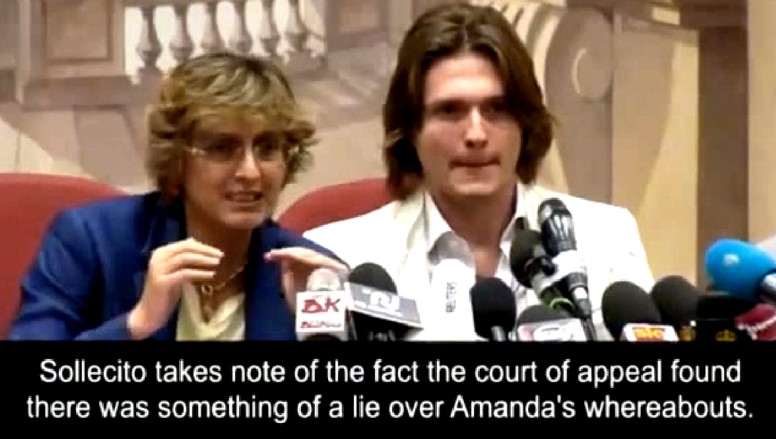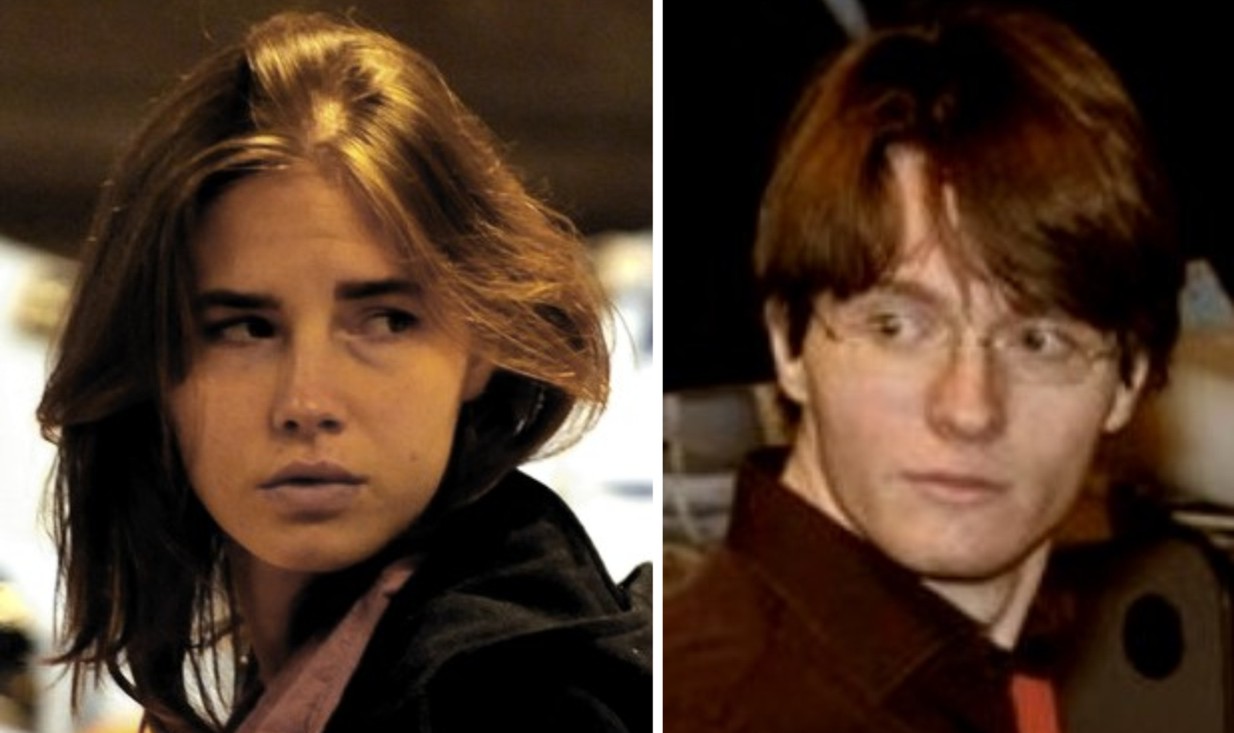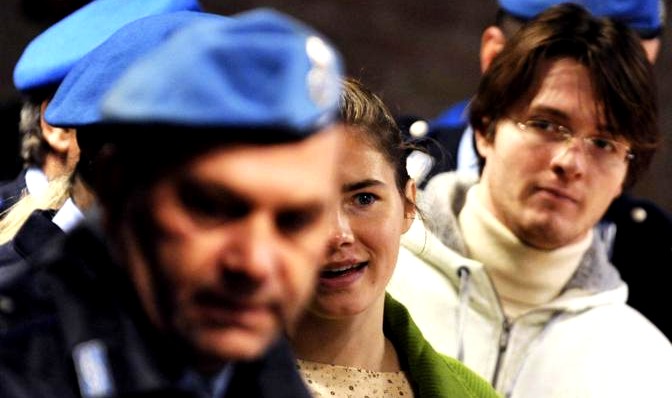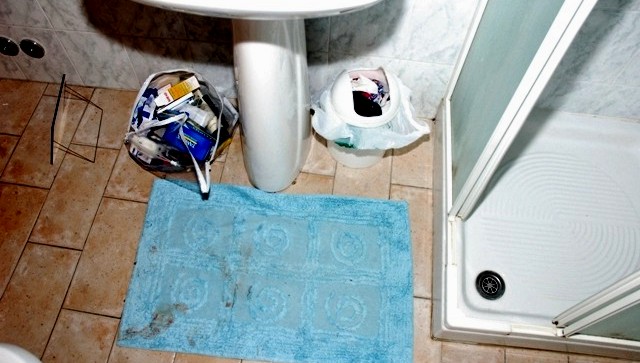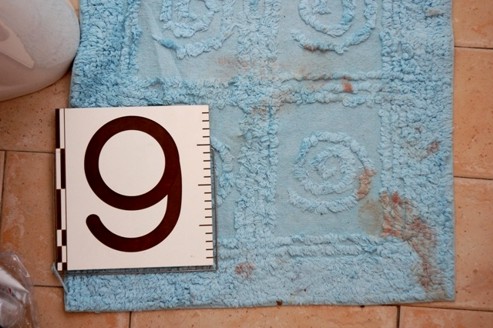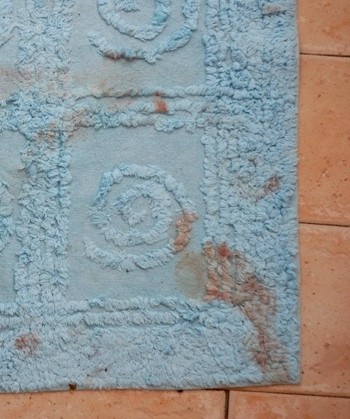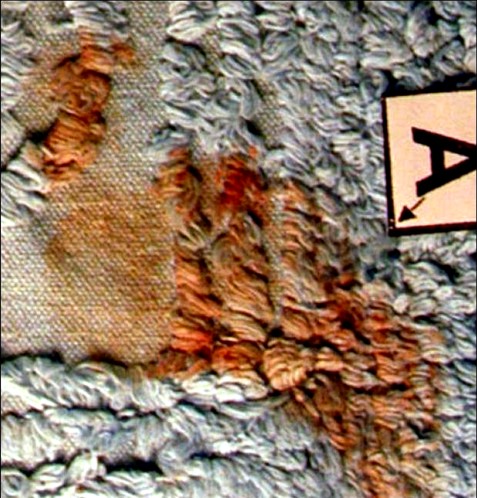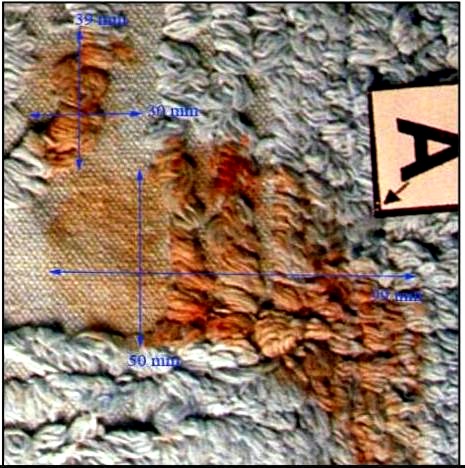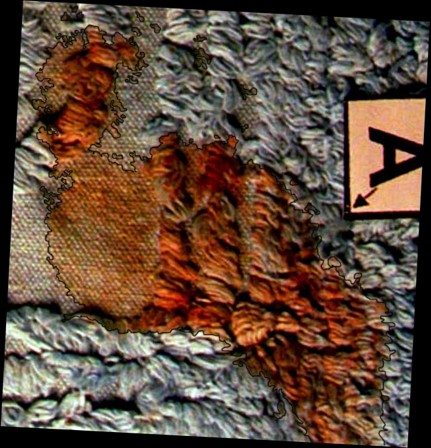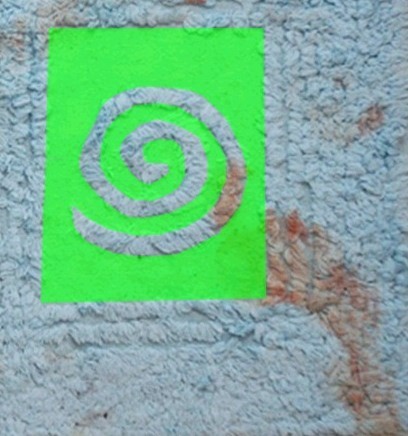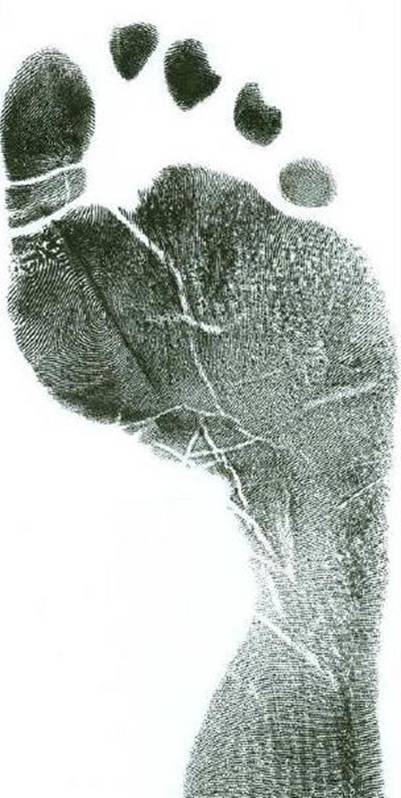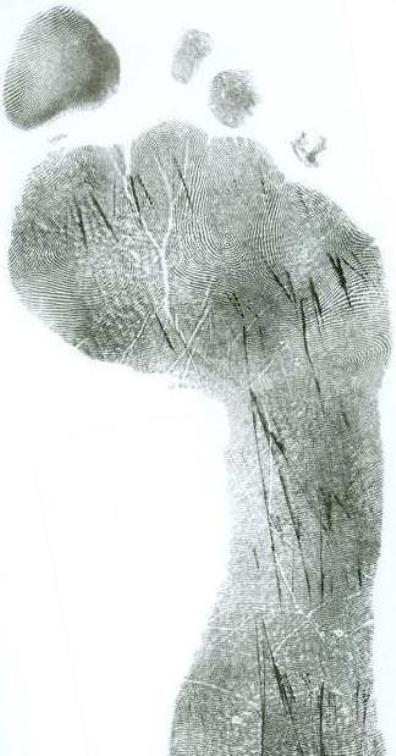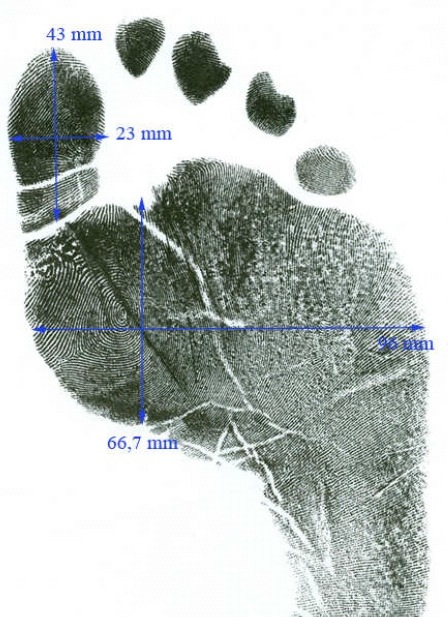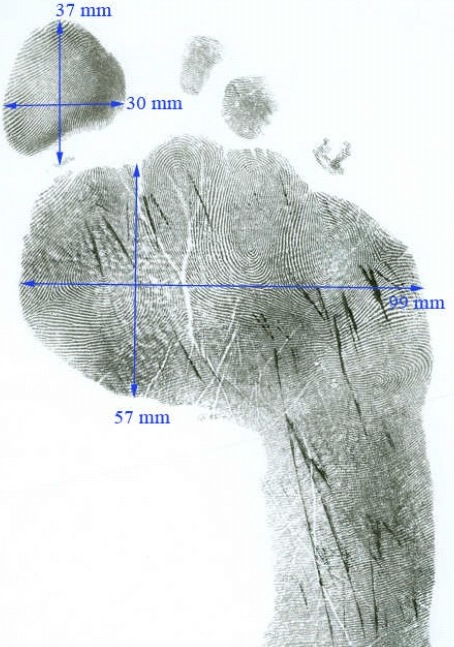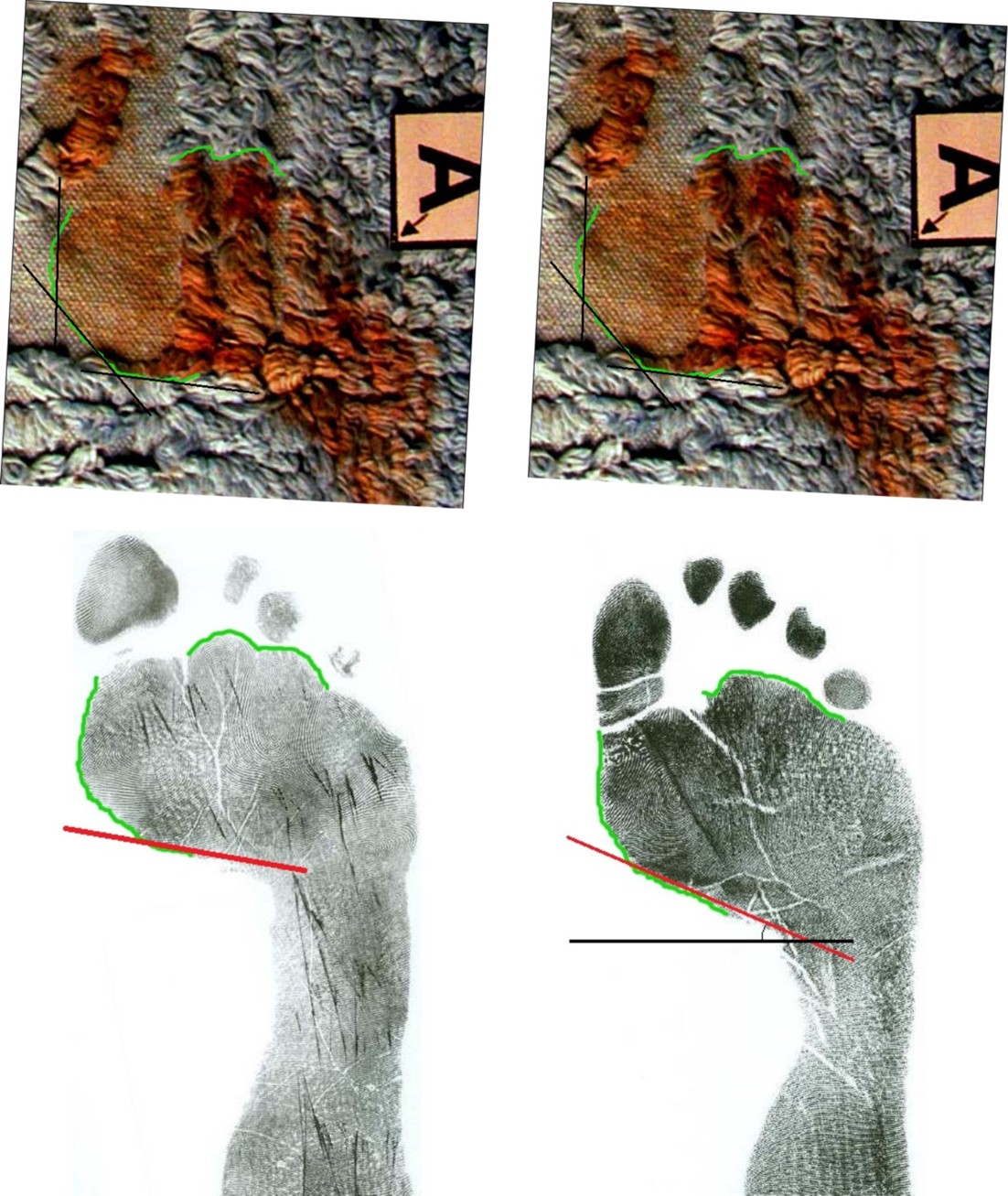
Category: Raff Sollecito PR
Wednesday, July 02, 2014
Rome Press Conference Reports: Sollecito Separates From Knox, Bongiorno Misleads On Her Text
Posted by Our Main Posters
1. Overview Of This Post
Sollecito and Bongiorno held a much-attended press conference at which they tried to hang Knox out to dry.
This post first quotes some of the reports and then looks at the big reveal, that there is proof Knox was out TWICE including later in the evening when Sollecito was still at home.
2. Reports From English-Language Media
Raffaele Sollecito, the ex-boyfriend of Amanda Knox who faces a 25-year prison sentence for the murder of Meredith Kercher, has placed renewed pressure on his American co-defendant by noting “certain anomalies” in her case.
As he unveiled his defence strategy for a potentially definitive appeal which could see him and Knox definitively convicted of the British student’s killing in 2007, the 30-year-old Italian said he still believed “to this day in the innocence of Amanda Marie Knox”.
But, in what some read as a sign he is preparing to distance himself from his former lover after six-and-a-half years of rigidly joint defence, he added: “But obviously, in what I read in the court papers, I register certain anomalies.”
While saying she hoped both convictions would be quashed by Italy’s supreme court, Sollecito’s lawyer, Giulia Bongiorno, urged the judges to take “coherent and consequent decisions” if they felt there were contradictions in the appeal court’s sentence, and not to “automatically extend anomalies pertaining to Amanda to Sollecito”.
At a press conference in Rome on Tuesday, Sollecito acknowledged, as he has done previously, that he cannot be absolutely certain of how much time the 27-year-old student from Seattle spent in his flat on the early part of the evening of the murder, even if he is certain the two spent the night together. The pair have always said their memories were foggy due to the effects of cannabis.
Sollecito’s appeal, said Bongiorno, focused on a text message which Knox says she sent from her then boyfriend’s home at 8.35pm the evening of the murder but which the Florence court, in its reasoning, accepts was sent from outside.
“According to the sentence, this [SMS] was not written from Raffaele’s house. Therefore the two were not together,” said Bongiorno. She added that, from her client’s point of view, the discrepancy was “either the nth mistake of the sentence, or ‘I [Sollecito] was lied to, too.’”
She added that his defence team had estimated that the attack on Kercher took place between 9pm and 9.30pm ““ though a time of death has never been agreed on and prosecutors have argued it occurred later. Sollecito says evidence from his computer proves he was at his home until at least 9.26pm.
Another hinge of his defence is a memo written by Knox in which she admitted to confusion over earlier statements in which she had falsely accused bar owner Patrick Lumumba of the murder, said she was present at her house and heard the 21-year-old Leeds University student “screaming”.
She later retracted the statements.
Sollecito said he did not believe the contents of the “odd, eccentric” memo, but that as the Florence appeals court ““ which reinstated the pair’s guilty verdicts in January ““ appeared to draw on parts of it for the convictions, he was forced to respond to that version of events.
“For me this memo recounts only fantasies and figments of the imagination,” he said. “But if what were written in the memo were true, taking it as a given that the judges are right [to use it in their verdict], could you explain to me where I figure in it?”
He added: “What is my participation? What is my motive, my involvement, anything? Explain it to me, because my name is Raffaele Sollecito and not Amanda Marie Knox.”
At a press conference in Rome on Tuesday, Sollecito insisted that he was innocent but said he remained convinced that Knox was too.
Unveiling his new defence strategy, he said January’s guilty verdict had been based on evidence from Knox that exonerated him.
“The 25-year prison sentence given to me is based entirely on the statement written by Amanda Knox in pre-trial detention. She herself exonerates me entirely,” he told press.
In the statement, she says she was in her flat while the murder was being committed, “with my hands over my ears because in my head I could hear Meredith screaming”.
Sollecito is not mentioned by Knox in the text, which his defence team says is proof he was not present at the scene.
“Taking it as read that the judges are right [in basing their verdict on Knox’s statement] will you please explain what I have to do with it?” Sollecito said.
Knox later withdrew the statement after saying she had written it under police pressure, and the pair have been each other’s alibis since, saying they spent the night together at his house.
Sollecito’s lawyer Giulia Bongiorno said that while he has always said he “spent the night” with Knox, he has never said they spent the evening together.
Ms Bongiorno added that her client’s appeal would cite a text message that Knox claims to have sent while with Sollecito at his house.
“This text message, according to the court’s own ruling, was not sent from his house. Therefore the pair were not together,” she said.
Despite throwing doubt on his ex-girlfriend’s alibi, the Italian said he had “always believed, and still believe, that Amanda Marie Knox is innocent.”
Knox and Sollecito have always maintained that they were together the evening of the brutal 2007 murder in Perugia, after which Miss Kercher, 21, was found half naked her throat slit in the cottage she shared with Knox.
But Sollecito’s lawyer Giulia Bongiorno said that ‘for the entire first part of the evening, they were not together. It’s this first part of the evening that’s new [to his defence]’.
Sollecito has pointed to phone records that show that Knox was away from his house for part of the evening.
In a dramatic change of legal tactics that he announced in a press conference in Rome he has now claimed there are “˜anomalies’ in Knox’s story.
Knox says that she received a text, while at Sollecito’s house, from her boss, telling her not to come to her job at a nightclub that night.
But phone records show that the text was received on the road between their houses, something that their retrial judges felt was key in their reconstruction of events. Sollecito’s phone and computer records show that he was at home that evening.
Sollecito said: “˜I have always believed in the innocence of Amanda. But I have to react to the accusations of the court and to the text message.
“˜Either the court has made their umpteenth mistake or she lied to me.’
He added: “˜I was in love with her and we had some very happy moments, but ultimately Amanda was a stranger.’
‘There are anomalies in her version of events. Against me there is nothing.’
The ‘fundamental basis’ for the conviction is Knox’s memo to police in which she says she was at the cottage when the murder took place, he said.
“˜I believe this was a hallucination, but if the court believes it is true then they have to accept that she did not say I was there. She gave me an alibi. “˜
It is not the first time Sollecito has expressed his doubts about the holes in Knox’s story.
In an interview with Italian television earlier this year, he said Knox had spent the night with him but went back to her place to shower, he said. When she returned, she was ‘very agitated,’ he said.
She told him that it looked like someone had broken in and that there was blood in the bathroom, Sollecito said. But rather than call the police, she showered and returned to his place something he finds odd. “˜Certainly I asked her questions,’ he said. ‘Why did you take a shower? Why did she spend so much time there?’
He didn’t get any real answers from her, he said.
3. Analysis: Bongiorno’s Claim About Knox’s Location When Texting
Giulia Bongiorno claimed yesterday that Amanda Knox replied to Patrick’s text while she was away from Sollecito’s house.
This is demonstrably untrue.
Mobile-phone-tower records show that Knox’s phone received Patrick’s incoming text telling her not to come to work when she was already somewhere on the route to his bar in Via Alessi. Knox apparently then turned around and went back to Sollecito’s house.
Mobile-phone-tower records show Knox texted back, responding to Patrick, from Sollecito’s house in Corso Garibaldi at 8:35.
They both claim this in their books - Sollecito himself claims it too. Those books are pretty suspect throughout, but for once they both tell the same truth.
Some five minutes later, Knox and Ms Popovic met at Sollecito’s house so Knox was still there then. That is still three to four hours away from the best estimate of Meredith’s death.
So the time-period prior to 8:35 pm when Knox texted from Sollecito’s flat was the only time-period when there is hard proof that Knox and Sollecito were ever apart that night. In her unforced statements on 5-6 November Knox did claim she went out alone to see Patrick, but we have only her word she was alone.
Here is the narrative from Judge Massei’s 2009 report.
− 20:18:12: Amanda receives the SMS sent to her by Patrick Lumumba, which let her off from having to go to work at the “šLe Chic”› pub on the evening of 1 November. At the time of reception the phone connected to the cell on Via dell’Aquila 5-Torre dell’Acquedotto sector 3, whose signal does not reach Raffaele Sollecito’s house. The young woman was therefore far [i.e. absent] from Corso Garibaldi 30 when the SMS reached her, as she was walking in an area which was shown to be served by the Via dell’Aquila 5-Torre dell’Acquedotto sector 3 cell. This point of her route could correspond to Via U. Rocchi, to Piazza Cavallotti, to Piazza IV Novembre, bearing in mind that Lumumba’s pub is located in Via Alessi, and that Amanda Knox would have had to travel along the above-mentioned roads and the piazza in order to reach the pub
− 20.35.48 Amanda sent an SMS in reply to Patrick, at No. 338-7195723; the message was sent when the young woman’s mobile phone was in Corso Garibaldi 30 or in the immediate neighbourhood. The cell used, in fact, was that of Via Berardi sector 7.
Here is the narrative from Judge Nencini’s 2014 report.
At 20.18 and 12 seconds, Amanda Marie Knox received a text message sent to her by Patrick Lumumba, in which he informed her that it would not be necessary for her to go to the bar to carry out her usual work. At the time of receipt, Amanda Marie Knox’s handset connected via the sector 3 mast at Torre dell’Acquedotto, 5 dell’Aquila, as shown by phone records entered in evidence. This mast cannot be reached from the vicinity of 130 Via Garibaldi, the home of Raffaele Sollecito. According to the findings of the judicial police entered in evidence, this mast could be reached by anyone in Via Rocchi, piazza Cavallotti or piazza 4 Novembre, all locations in Perugia which are intermediate between 130 Via Garibaldi, the home of Raffaele Sollecito, and Via Alessi, where the “Le Chic” bar is located.
From this set of facts established in the case, Amanda Marie Knox’s claim, according to which she received Patrick Lumumba’s text message while she was at 130 Via Garibaldi, appears false. Given the mast connected to and the time, it is reasonable to assume that, when Amanda received the message, she had already left Raffaele Sollecito’s home and was on her way to the “Le Chic” bar. Presumably, she then turned around and went back.
Here, then, is the first crack in the account of the young woman who, in her narrative, claims never to have left the house at 130 Via Garibaldi from the moment of her entrance into the house in the afternoon of 1 November 2007, together with Raffaele Sollecito. There is oral evidence (the deposition of Popovic) and evidence obtained through phone records that, at around 18:00 on 1 November 2007, Amanda and Raffaele were at the home of the latter. Later, at precisely 20:35 and 48 seconds, when Amanda Marie Knox sent a text message to Patrick Lumumba, connecting to a mast serving 130 Via Garibaldi, both were once again [118]together at Raffaele Sollecito’s home. This fact is confirmed by Popovic, who went there to cancel that evening’s appointment with Raffaele. In fact, the witness reported that she had visited Raffaele’s home at around 20:40 in the evening.
In essence, it can be established with certainty that Amanda and Raffaele were apart, albeit for a limited period of time, on the evening of 1 November 2007, contrary to what is stated repeatedly in multiple statements made by Amanda Marie Knox.
It seems Bongiorno got it wrong about Knox, and Sollecito sat beside her happily nodding his okay.
Amanda Knox Left Sollecito’s House By Herself? Both Claimed It But Neither Of Their Books Back It Up
Posted by Our Main Posters
1. Current Contexts Of Sollecito’s And Knox’s Books
Neither book is exactly riddled with truths.
The claims throughout Sollecito’s book are soon to be the subject of a trial in Florence and the claims throughout Knox’s book are soon to be the subject of a trial in Bergamo. So both will need to endorse or reject what they wrote.
Plus Knox will need to endorse or reject this, from the first unforced statement she insisted on making without a lawyer on 6 November 2007. This is what Sollecito is gleefully using against her now.
Last Thursday, November 1, a day on which I normally work, while I was at the house of my boyfriend Raffaele, at around 8:30 pm, I received a message on my cellular phone from Patrik, who told me that the premises would remain closed that evening, because there were no customers, and thus I would not need to go to work.
I responded to the message by telling him that we would see each other at once; I then left the house, telling my boyfriend that I had to go to work. In view of the fact that during the afternoon I had smoked a joint, I felt confused, since I do not frequently make use of mind-altering substances, nor of heavier substances.
I met Patrik immediately afterward, at the basketball court on Piazza Grimana, and together we went [to my] home.
2. From Sollecito’s Honor Bound (Simon & Schuster 2012)
Amanda and I smoked a joint before leaving the house on Via della Pergola, wandered into town for some shopping before remembering we had enough for dinner already, and headed back to my place. Shortly before six, a Serbian friend of mine named Jovana Popovic rang the doorbell and asked if I’d mind driving her to the bus station at midnight to pick up a suitcase her mother was sending. I said that would be fine. When she left, Amanda and I sat down at the computer to watch a favorite movie, Amélie.
We had to stop the film a few times as the evening wore on. First, Amanda got a text from Patrick telling her it was a slow night because of the holiday and he didn’t need her to come in after all. It was like getting an unexpected snow day””we were thrilled. Amanda texted back: Certo ci vediamo più tardi buona serata! Sure. See you later. Have a good evening.
Then my father called. He and Mara had just seen the Will Smith movie The Pursuit of Happyness, and he told me how beautifully it portrayed the relationship between a father and his son. My father was always making phone calls like this. It was sweet that he wanted to share his experiences, but he also made everything he said sound vaguely like an order, as if laying out the parameters of how I should react to things before I’d had a chance to form my own opinion. But he never stayed on the line for long””he is too nervy and impatient””so I listened calmly and the call was over in less than four minutes.
In the meantime, Jovana dropped by again and told Amanda that I didn’t need to drive her to the bus station after all. Now we didn’t have to leave the apartment. The evening was ours, and we couldn’t have been happier. We switched off our cell phones, finished watching Amélie, and discussed what to make for dinner…
When Amélie ended, I went into the kitchen to take care of some dishes left over from breakfast before we started making dinner. I soon realized that water was leaking out of the pipe under the sink, and I cursed under my breath. I’d had a plumber come and fix the sink just a week earlier, and he had made me buy all sorts of replacement parts that clearly were not put together properly. I suspected he had left them loose on purpose to force me to pay for another visit. As Amanda and I threw kitchen towels onto the puddle on the tile floor, I decided I was going to let my landlady deal with it from now on.
“Don’t you have a mop?” Amanda asked. I did not. She offered to pick one up from Via della Pergola the next morning and bring it round.
We cooked a fish dinner, did our best to wash the dishes again, and tumbled gratefully into bed in each other’s arms. Only later, when I lay in the dark, unable to sleep, did it dawn on me that Papà had broken his usual habit of calling to wish me good night.
It turned out he did so out of consideration. He had been about to pick up the phone when my stepmother talked him out of it. “Stop bothering him,” Mara said, as they got ready for bed around eleven o’clock. “He’s with Amanda, and they want to be alone. Why don’t you send a text instead?”
My father took her advice, but because my cell phone was turned off, I didn’t receive the message until six the next morning.
It was a desperately unlucky combination of circumstances. If my father had tried my cell and then called me on the home line””which he would have done, because he’s persistent that way””I would have had incontrovertible proof from the phone records that I was home that night. And the nightmare that was about to engulf me might never have begun.
My father called my landline a little before nine thirty the next morning to make sure we would be ready for our day trip to Gubbio. I was too groggy to talk. I’d been up several times in the night””listening to music, answering e-mail, making love””and wanted only to go back to sleep. Amanda got out of bed and said she was going home to shower and change her clothes, so I walked her to the front door, gave her a kiss, and crawled back under the covers.
3. From Knox’s Waiting To Be Heard (HarperCollins 2013)
Raffaele and I were good at being low-key together. We chilled out in the common room and smoked a joint while I played Beatles songs on the guitar for an hour or so. Sometime between 4 P.M. and 5 P.M., we left to go to his place. We wanted a quiet, cozy night in. As we walked along, I was telling Raffaele that Amélie was my all-time favorite movie.
“Really?” he asked. “I’ve never seen it.”
“Oh my God,” I said, unbelieving. “You have to see it right this second! You’ll love it!”
Not long after we got back to Raffaele’s, his doorbell rang. It was a friend of his whom I’d never met””a pretty, put-together medical student named Jovanna Popovic, who spoke Italian so quickly I couldn’t understand her. She’d come to ask Raffaele for a favor. Her mother was putting a suitcase on a bus for her and she wondered if he could drive her to the station at midnight to pick it up.
“Sure,” Raffaele said.
As soon as she left, we downloaded the movie on his computer and sat on his bed to watch it. Around 8:30 P.M. I suddenly remembered that it was Thursday, one of my regular workdays. Quickly checking my phone, I saw that Patrick had sent me a text telling me I didn’t have to come in. Since it was a holiday, he thought it would be a slow night.
“Okay,” I texted back. “Ci vediamo più tardi buona serata!”””“See you later. Have a good evening!” Then I turned off my phone, just in case he changed his mind and wanted me to come in after all. I was so excited to have the night off that I jumped on top of Raffaele, cheering, “Woo-hoo! Woo-hoo!”
Our good mood was only elevated when the doorbell rang again at 8:45 P.M: Jovanna had come back, this time to say that the suitcase hadn’t made the bus and that she didn’t need a ride after all. With no more obligations, we had the whole rest of the night just to be with each other and chill out.
After the movie ended, around 9:15 P.M., we sautéed a piece of fish and made a simple salad. We were washing the dishes when we realized that the kitchen sink was leaking. Raffaele, who’d already had a plumber come once, was frustrated and frantically tried to mop up a lot of water with a little rag. He ended up leaving a puddle.
“I’ll bring the mop over from our house tomorrow. No big deal,” I said.
Raffaele sat down at his desk and rolled a joint, and I climbed into his lap to read aloud to him from another Harry Potter book, this one in German. I translated the parts he didn’t understand, as best I could, into Italian or English while we smoked and giggled.
Later, when we were in bed, our conversation wound its way to his mother. His dad had divorced her years before, but she’d never gotten over the break. In 2005 she had died suddenly. “Some ¬people suspect she killed herself, but I’m positive she didn’t,” Raffaele said. “She would never do that. She had a bad heart, and it just gave out. It was horrible for me””¬we were really close””¬and I miss her all the time.”
I felt terrible for him, but it was hard for me to relate. The only person I knew who had died was my grandfather, when I was sixteen. I felt sad when my mom told me, but my grandfather had been old and sick, and we had expected his death for a few weeks.
I’m sure Mom and Oma must have cried, but my strongest memory is sitting around the dining room table telling funny stories about Opa. My grandmother’s message””that grieving was something you did in private; that you didn’t make public displays and you kept on moving forward””had remained with me.
Hearing the pain in Raffaele’s voice, I hurt for him. Nestling my head on his chest, I tried to be comforting.
As we started kissing, Raffaele gave me a hickey on my neck. We undressed the rest of the way, had sex, and fell asleep.
We’d known each other for exactly one week and had settled so quickly into an easy routine that one night seemed to melt happily and indistinguishably into the one that came after.
We planned to break our routine the next day, All Souls’ Day, by taking a long drive into the countryside, to the neighboring town of Gubbio. The November 2 holiday wasn’t usually observed with as much fanfare as All Saints’ Day, but since it fell on a Friday in 2007, a lot of people, including us, were turning it into a four-day weekend. I thought, Italians having a good time again. And I couldn’t wait.
Monday, June 30, 2014
Apart From Cassation’s Unyielding Mandate, More Problems With The Belated Sollecito/Bongiorno U-Turn
Posted by Our Main Posters
1. The Appeal’s Grounds For Separation
That bizarre infatuation of Bongiorno’s with Knox as Jessica Rabbit is clearly long-gone.
Now the poor boy was home alone and the absent Miss Rabbit had reason and opportunity. Tiziano posted these ten translated points from the new Sollecito appeal to Cassation, which seems to have the highly nervous Knox camp’s tongues tied.
Among the numerous flaws the proceedings appealed against present, the one linked to the claimed impossibility of differentiating between the two accused stands out.
On this point the Appeal Court denied any in-depth analysis at all of the individual roles - an investigation urged by the defence - avoiding taking any position about alternative constructive hypotheses.
10 points are enumerated by the defence in this regard:
- AK’s memorial referring to events at via della Pergola was in the singular
- AK reported receiving SMS not to go to work from Lumumba, but went out just the same
- AK admitted having lied to RS
- RS did not calumny anyone: the accusation against PL was never confirmed by RS
- AK in her memorial positioned only herself at the crime scene at the time of the scream
- only AK’s blood was on the knife blade
- no mixed traces RS/MK were found and highlighted by luminol in the house
- Quintavalle claimed to have seen AK the morning of November 2nd, not RS
- RS did not know RG and had no reason for wanting MK’s death
- the alleged bad relations and the question of disappearance of money regarded only MK and AK
2, Popper Explains Why They Will Go Nowhere
Popper the highly informed Italian commenter on TJMK and PMF has explained on a previous post why this will fall on deaf ears in Cassation.
if RS said something he has not said before it would make no difference now. No more evidence can be admitted at the trial.
Fase istruttoria is over as judgement of merit. Cassazione can only respond on points appealed and they must be points of law otherwise they are not admissible. Defendants do not talk in hearing.
Once they are convicted, for example, if he had new information on the case and new evidence that proved (in a convincing way) he is not guilty, he could ask for revisione, basically a review of the trial.
He clearly has nothing to say though ... if he said she went out, judges knew that already. If he said that night he was in Milan and could prove it conclusively, that could trigger a review of a final sentence.
We are clearly talking in theory, no such thing will happen.
3. Could The 10 Points Have Worked Previously?
If Judge Nencini was still in the saddle could the ten points have had merit?
Our continuing Interrogation Hoax series has been hammering on the fact that on 5-6 November 2007 quite unpressured Knox herself did state that she went out alone without Sollecito on the night Meredith was murdered.
But these ten cherrypicked points above and a claim that RS was not even at Meredith’s house that night are self-destroying over-reach. They would not have caused a win or partial win for Sollecito. Not one of them stands up as a get-out-of-jail-free card upon close readings of the reports of Judge Massei and Judge Nencini.
The lower courts did NOT deny analysis of the individual roles - the two themselves opted to be tried together, while Rudy Guede, fearing two snakes, chose to be tried separately.
WHEN did the defense urge investigation of their differing roles? What did the Massei trial court miss? It had many months of the sight of Sollecito - sitting there sulky, saying little, not taking the stand. Yes, not assisting Jessica Rabbit with an alibi, but that was not so obvious.
The wounds on Meredith and the evidence points in Meredith’s room point overwhelmingly to three attackers. They prove the use of two knives from opposite sides. It was Sollecito’s knife that was used for the fatal blow; that remains unshaken - actually, more confirmed by the Carabinieri.
See Ergon on the implacable knife evidence. Sollecito was the knife fetishist, and the one who was already into the cocaine or crystal meth that Knox was probably on judging by her telling smell the next day, her bizarre behaviors through the week following, and her odd money trail.
See the implacable evidence against him on the bathmat by SomeAlibi and Yummi. That footprint had to have been imprinted within a few minutes of the end of the attack on Meredith.
After the hijacked Hellmann appeal in 2011 Sollecito was deeply craven to Knox and her family and entourage on the US west coast. Craven to the extent that his own family (which despises the Knox-Mellases and blames Knox for his predicament and their lost name and enormous expenses) once hurriedly hopped on an aircraft to Seattle to enforce their separation.
Sollecito’s hapless book-agent Sharlene Martin and shadow-writer Andrew Gumbel both live on the West Coast and Knox’s radioactive FOA obviously provided most of the malicious fantasy that constitutes his defamatory book.
Playing chicken with the Italian justice system is notoriously suicidal. The crazy aggression of the Prestons, Fischers and Moores did not help Sollecito at all at the Nencini appeal (though it helped Knox even less - she got handed the longer sentence.)
The gods-in-their-own-minds in the FOA got Sollecito no US job and no US viza. The email to Judge Nencini and the appeal to ECHR and the promised fight against extradition for Knox are to him merely insults, and attempts to separate Knox off.
So, back in Italy, he is confused, let-down, disgruntled, and loaded for bear. Knox was the loose canon in 2007, Sollecito is the loose canon now.
Here is a key exchange between our main posters SeekingUnderstanding and Hopeful from previous threads.
4. Take On RS Now By SeekingUnderstanding
[t does seem so very sad and frustrating that Raphaele did not open the window of opportunity, as Judge Nencini tried to nudge him to do, just before Christmas.
He is less easy to read than Ms. Knox , for a number of reasons - more introverted, less articulate (certainly in English; but he also doesn’t seem expressive in his own language), and because of the psychology itself.
You may remember I suggested AK finds it unbearable to acknowledge her darker side, to own her projections; unbearable to be thought of as ‘a monster’, to be unlovable, or indeed hated by people. This may be a strong component in her lying.
I believe Raphaele also finds things unbearable, but whereas Amanda appears to turn this unbearable feeling into lashing out to others, - I think in Raphaele, he finds himself and ‘what has happened to him’ (passive aggression) unbearable. His judgement has not only been poor, but catastrophically poor, - and he must know this. One wonders why the self-destruct.
He knows his life is ruined, and he knows his appalling judgement was instrumental. He truly doesn’t have confidence in himself, but bluffs anyway. His ‘ex’, by contrast,has too much. If only she could have self-doubt, and feel shame.
He is not unintelligent, by no means, yet his choices and decisions at times have seemed near idiotically stupid. So there must be something else going on, something deep in his psyche that causes such confusion in his mental and emotional universe.
He seems unable to organize his emotions. He appears to want or expect or need a woman to ‘sort them out’ (sort him out). His relationship with his mother would probably reveal the source of this. How did she manage her emotions? Or did they rule her? . These are the sort of questions I might be asking. He seems overwhelmed, swallowed up by the juggernaut that AK set in motion.Was his mother easily overwhelmed by life’s problems? Something has gone wrong (drastically) with a healthy model for his ‘anima’.
Where Amanda is the arch manipulator, he is highly manipulable. He seems to copy. Like her, his self-identity is weak, but for different reasons. Drug use, I would suggest, has been both crucial and disastrous for his mind. From this point of view, prison will be a constructive environment for him, (as AK too). Perhaps without the distorting and illusory aspects of drugs he might begin, over many years, to experience true spiritual (and therefore moral) issues.
I always think drugs give a delusion of spiritual experience (‘the highs’), - wanting them can be (for an introvert) indicative of longing for something more spiritual, but using them will actually prevent such an experience, emphatically.
So then there is bitterness and emptiness, as well as despair and, still, confusion. Thus the addiction which starts as a cycle in the mind.
I knew a psychologist who worked with highly motivated and successful people in the Arts - people who would have burn out, creativity, and performance issues. He was extremely clever. But he was adamant that there had to be a hierarchy for dealing with problems.
That is to say, if someone was using drugs and/or alcohol to the point of misuse (extremely common in the performing arts), - this problem had to be mastered and dealt with FIRST, before anything else could even be addressed. This may seem irrelevant (as Sollecito hasn’t shown he is creative), - but I would
say the signs are that his past (and current?) drug use needs to be sorted before anything else can possibly be.Such a destructive shame that this has all dragged on for 7years.
I don’t think he has any idea as to how to give a ‘press conference’ - even supposing , by a miracle, he was going to tell the unadulterated truth. He is way out of his depth. I doubt he has sufficient communication skills in his own language, let alone In English for the American media.
5. And The Take Of Hopeful On RS Now
As he is back in the spotlight for the July 1 press conference, your observations about him are timely. He does seem more introverted than Knox, and less articulate. Correct me if I misinterpret what you said about him, that rather than lash out at others aggressively like Knox does to disperse and blame others for her awful feelings about her dark side, Sollecito does the opposite and feels the weight of shame but turns the unbearable feelings inward. He is poster child for passive-aggressive.
I also believe he does have a sense of deep loyalty and faithfulness to his family, since his father has never abandoned him nor did his mother. He has misplaced loyalties at times, and combines a stubborn streak with false sense of need to persevere after he has made wrong steps.
This comment is mainly a review of what you conclude about Raf, but bears repeating. He is ashamed of his “catastrophically bad judgment.” I agree, his pride is wounded, his vanity more than his love for Knox.
I believe Raffaele sincerely regrets what he realizes he has done to his own family, but still can’t quite confess it. Maybe part of him is sorry but part of him is secretly glad he is controlling his father’s destiny, in punitive action for divorcing his mother. He also sent his sister’s career down the cliff. His sister is really to blame for that so with true passive-aggressive deceptiveness he can hide his responsibility for it while causing it.
His wanky emotions have made a trainwreck of his intelligence and caused him to do “idiotically stupid” things and self-destruct.
His drug use to relieve inner confusion caused by lack of self-identity is a coping method that does more harm than good. His patience is more of a drug stupor that makes him slow to act, than real gritted teeth patience, which may be why we’ve waited this long (6 years) for him to reveal the truth about Knox.
He stayed in a cloud of marijuana until she came along. She liked the drugs, too. He allowed her to set the course of his life because he needed or wanted a woman to sort out his emotions. Maybe he was competing with dad with a new hot blondie, too. He didn’t fathom that Knox would become so extreme and so terrifying.
He underestimated Knox, and she saw she could manipulate and destroy him with one hand tied behind her back. She reveled in the besotted weakling, and she felt superiority over Guede too, and soon despised them both. She wouldn’t fall into some darkened room or quiet void of depression like Raffaele’s mom had done giving up on life. The insulated quiet Italian boy raised scrupulously did not see that with Knox he would be “swallowed up in the juggernaut AK set in motion”. He wanted her power and excited vision, but he couldn’t understand her mental illness that went with it. Love is blind.
As long as he could blame her and not himself maybe he was OK with it, especially with drugs to dull the pain, until he felt the full impact of her punishment and years later her treachery. Finally he grew a brain and saw it was Knox who betrayed him, not vice versa. Maybe the press conference is to set that straight.
His drug use got him through much of his first year of prison when he lost all sense of time and space. He was a basketcase. He probably used meds his last 3 years behind bars as well. Perhaps Dr. Sollecito saw that his son got legal prescriptions for him, maybe even purchasing prison favors that way, who knows?
Maybe Knox scoffed at Raf’s crutch, and she continued to compete with him behind bars. She scoffed at her mom for taking antidepressants. Knox had no room to talk as she herself was reportedly a massive drug user at UW and in Italy found a job where liquor flowed.
Has Raf continued the drug use? Does Greta his new girlfriend use drugs? Or has he sworn them off motivated by anger and determination to clear his head for his legal fight?
The concept of “anima” is unknown to me, although the term is familiar. I will research it online, thank you. Your insights are always valuable, thank you for sharing them. Thanks for educating us in the short comment format which can’t do justice to your full knowledge of the subject, but does shed a lot of light and points the way.
Raffaele’s mother and her sad demise seem to be at the root of her son’s depression. Raf has lack of confidence and the need to bluff where he feels no real power. He and Knox are still learning tricks from each other.I think Knox may have been a father-figure to him in a twisted way, because Amanda is energetic and adventurous and for a short while in Perugia seemed to have it all together and be a hard worker like his dad. Raf met Knox at the peak of her exhileration with her new life in Italy. Like a drug high, it might not have lasted. He was completely deceived.
He may have felt he could never compete with his older sister who might have seemed to him like Amanda and his dad: energetic, capable, feet on ground. This is probably what Raf needs in his life.
Raf commented on Knox living life as if in a dream, there was no reality in her mind, she lived only for pleasure. Maybe he did not like this side of her. This was his wakeup call and he spoke about it openly because it was something he didn’t like, having thought at first glance she was a strong American. He didn’t know whether to attribute her odd mental impracticality to her nationality, her genetics, her femaleness, or her unknown religious upbringing. He had no clue, and maybe it even made him feel stronger and more grounded by comparison since he had formerly thought of himself as a tetherless dreamer but he didn’t want another spaced out confused dreamer like himself for a partner and was having second thoughts. He preferred her rough kick-butt side. She was the brother he never had, a wild West type, a cowboy to climb trees with and roam the range, the key to a new country after his launch to Munich didn’t work out.
In early childhood Raf maybe got labeled or saw himself as “slow” or “dumb” and began to live a self-fulfilling prophecy. He might have felt misunderstood knowing that he did have a lot of intelligence, but that he did not have the same personality as his dad or sis, and not wanting to be equated with his pushed aside mom. He must have felt very alone.
He also may be carrying a lot of shame about his MPD Psycho habit and his secret fantasy life of violence.
Raffaele may have been turned off yet partly tantalized by his father’s profession. A doctor sees a lot of blood and gruesome things with the body.
Raffaele may hero worship a father who can face such grotesque things without wincing, and a sister who had power with the police and saw crime victims.
You mention the Arts and a psychologist who treated performers with burnout and creative types who needed help or a life coach. Maybe Raffaele does see himself as more that artsy type of person, someone wanting to create computer games, sci-fi fantasy, or be an “Experience Teller”. He did write a book, so maybe he does fall into the category of artistic temperament, which often needs a guide or an infusion of stiffened backbone to face the realities of life in a business sense.
Knox seems to be struggling with math, yet her mom is a math teacher and her dad an accountant.
Saturday, June 28, 2014
Sollecito Suddenly Remembers He Wasnt There But Cannot Speak For Knox Who (As She Said) Went Out
Posted by Peter Quennell
1. The State Of Play
Sollecito is becoming intent again on digging himself out (really). But he and his own team have created definite problems.
Consider for example the last two public performances by Raffaele Sollecito’s defense, both in Florence. They consisted of:
- 1. Giulia Bongiorno in her summation back in January, in Florence, at the tail-end of RS’s and AK’s appeal, ranting on foolishly about Perugia and Rome justice officials, in an apparent attempt to outdo even the nastiness of Amanda Knox’s earlier email to Judge Nencini which also ranted on foolishly about those officials.
2. Giulia Bongiorno fooishly taking strong offense to Judge Nencini wondering why Sollecito remained soomewhat bound to Knox and so little forthcoming, and then Bongiorno foolishly having her political allies advance a complaint to the Supreme Council of Magistrates, dropped after a brief investigation.
Yes that is the same Judge Nencini who already reacted firmly to abrasive pressure from the Knox camp. And the same Judge Nencini to whom Cassation MUST refer the case back down if there is to be any hope of adjustment of the outcome of the appeal.
Bongiorno’s were not exactly the smartest of moves.
3. Today’s New Development
An apparent u-turn, or at least a blink and slight deviation, in the suicidal game of chicken the Knox and Sollecito camps have long thought to be so smart.
Bongiorno or others very close to Sollecito, probably including his father and an aunt, seem to be again shooting for an additional degree of separation.
This familiar loosening of bonds with Amanda Knox was apparently explicit in his appeal to Cassation and today it is made slightly more explicit by Sollecito in a magazine interview.
And next Tuesday the Sollecito team will stage a press conference.
2. Fraught With Problems
The Sollecitos would be wise to bump up their plea to Cassation about 100-fold. Substantial evidence that Sollecito was at the house still looms like an 80,000 pound gorilla - see a listing of it in one of our next posts.
And one key thing about the Italian system: it has immense capacity to hit back very hard in response to out-of-court pressure and attempts to poison public opinion.
As we have explained previously, these strong powers originate in the endless fight against the mafias, which have long used defamation of justice officials as a way of seeking some relief for their guys.
The reason why Knox is sentenced to 28 and a half years on top of her three years served for calunnia doesnt yet seem to have sunk into the slow minds of Knox or her family or her vigilantes..
But Sollecito is increasingly alive to the ability of Italian justice to hit back very hard when the justice system and its officials are impugned.
Yesterday Sollecito and his lawyer Alfredo Brizioli were being interviewed for the multiple false charges of crimes in Honor Bound The book is pretty horrific and new charges seem certain.
The foolish shadow-writer Andrew Gumbel has surfaced, and appointed a lawyer, and is expected to join him.
Our guess? Sollecito will need to tell all, and make a major plea for forgiveness from the Kerchers, if any adults with real powers are to give him any break.
Friday, June 20, 2014
Knox Interrogation Hoax #6: Sollecito Transcript & Actions Further Damage Knox Version
Posted by Our Main Posters
1. Breaking News From The Sollecito Appeal
It is in effect being reported (see below) that the Sollecto team have asked Cassation to concede that back in 2008 they - Cassation - maybe made a mistake in the law.
That, the Sollecito team said, directly caused a disadvantage to their guy. And they may very well be right. If Cassation agrees, it may leave Knox with no further effective fight.
2. What Happened When Knox Was “Interrogated”
To fully understand this, it will pay you to have read this series which includes major new translations by the professional translator ZiaK. And especially Part 2 of the previous post.
You will see repeatedly confirmed by those who were there these key facts:
(1) Amanda Knox turned up at the Perugia central police station late at night, unwanted and grumpy, and was advised to go home and get some sleep.
(2) Inspector Ficarra later said if she really wanted, she could help, she could build a list of possible perps, in a recap/summary session (not an interrogation).
(3) For maybe 45 minutes, starting at 12:30 am (when the interpreter arrived), Knox quite calmly listed seven names along with maps drawn.
(4) Knox was then quietly told Sollecito had contradicted her alibi (see his newly translated statement below). Knox had no immediate reaction.
(5) Soon after, Knox had a wailing conniption, which really startled the four others present, when Knox saw an outgoing text to her boss she had just said wasnt there.
(6) Police did what they could to calm her down, and she insisted on writing out three statements (see below) in supposed elaboration in less than 12 hours.
(7) She was warned she should have a lawyer each time, the second warning by Dr Mignini, but each time she shrugged off this advice and pressed on.
(8) In the noon statement Knox said this, with no mention of having been coerced: “The questions that need answering, at least for how I’m thinking are… 2. Why did I think of Patrik?”
3. More About Knox’s Three Statements
Cassation ruled in April 2008 that the first two statements could not be used to indict Knox at the murder trial, but all three could be used to argue her framing of Patrick.
All three of Knox’s voluntary statements of 5-6 November say she was at her house with Patrick; the main thrust of the third statement (handwritten when she knew Patrick was being held nearby and may have proved her a liar at any minute) was to spread the accusations around a bit more, and drop Sollecito also in the soup
But the voluntary 1:45 and 5:45 statements also include these damning claims:
Statement 1:45: “I responded to the message [from Patrick] by telling him that we would see each other at once; I then left the house, telling my boyfriend that I had to go to work.
Statement 5:45: “I wish to relate spontaneously what happened because these events have deeply bothered me and I am really afraid of Patrick, the African boy who owns the pub called “Le Chic” located in Via Alessi where I work periodically. I met him in the evening of November 1st 2007, after sending him a reply message saying “I will see you”. We met soon after at about 21.00 at the basketball court of Piazza Grimana. “
See the possible opportunity for Sollecito’s team via the new appeal here? That’s one supposed “proof” that he wasn’t there (or at most came late, to explain his footprints and DNA).
And see the really big problem for Knox? She says she went out from Sollecito’s place on the night - and quite specifically says he did not come along.
4. Dr Mignini’s View On Cassation Ruling
Dr Mignini has several times observed that Cassation misunderstood that Knox herself had insisted on all three statements, ignoring advice he and investigators gave her.
But he did not think it was a make-or-break issue, and to him Cassation is almost invariable respectful and benign. And many Italian legal precedents say yes, in those circumstances those statements really should have been permitted exhibits at the main trial.
5. Now Sollecito Team Agrees With Mignini
1) Read the excellent new report by Andrea Vogt here (her Update of 19 June 2014) which in part quotes the Sollecito appeal saying this:
“The trials lacked an adequate review of the “individual” role of Sollecito, generating instead a sense of his guilt due to… a “confession” made by her, which never mentioned him at the scene of the crime. 1a) That declaration should be used as a favourable element showing Sollecito was not at the scene of the crime, not as a piece of evidence that confirms his guilt.
2) Also read the new report by Barbie Nadeau here [with the caution by Popper in Comments below] which in part says this.
Now, for the first time in this seven-year long, painfully epic case, Sollecito wants to be judged independently from Knox””if not on the case as a whole, at least on the issue of the so-called “false confession.”
6. Sollecito’s Statement Early 6 November 2007
Perugia Police Headquarters
Flying Squad General Affairs Area.
SUBJECT: Witness statement of person informed of the facts given by SOLLECITO Raffaele, already identified.
On November 5th 2007 at 22:40 in the offices of the Flying Squad of the Perugia Police Headquarters. Before the undersigned of the Criminal Investigation Dept. Deputy Commissioner MONICA NAPOLEONI, Chief Inspector Antonio FACCHINI Vice Superintendent of Police Daniele MOSCATELLI, Assistant Chief Ettore FUOCO is present the above-mentioned who, to supplement the declarations made [November] in these Offices, in regards to the facts being investigated, declares as follows: [*A.D.R. = Question Answer = QA]
QA I have known Amanda for about two weeks. From the night that I met her she started sleeping at my house. On November 1st, I woke up at around 11, I had breakfast with Amanda then she went out and I went back to bed. Then around 13:00-14:00 I met her at her house again. Meredith was there too. Amanda and I had lunch while Meredith did not have lunch with us.
QA Around 16:00 Meredith left in a hurry without saying where she was going. Amanda and I stayed home until about 17:30-18:00.
QA We left the house, we went into town, but I don’t remember what we did.
QA We stayed there from 18:00 until 20:30/21:00. At 21:00 I went home alone because Amanda told me that she was going to go to the pub Le Chic because she wanted to meet some friends.
QA At this point we said goodbye and I headed home while she headed towards the center.
QA I went home alone, sat at the computer and rolled myself a spliff. Surely I had dinner but I don’t remember what I ate. Around 23:00 my father called at my home number 075.9660789. During that time I remember Amanda had not come back yet.
QA I browsed at my computer for another two hours after my father’s phone call and only stopped when Amanda came back presumably around 1:00.
QA I don’t remember how she was dressed and if she was dressed the same way as when we said goodbye before dinner.
QA I don’t remember if we had sex that night.
QA The following morning around 10:00 we woke up, she told me she wanted to go home and take a shower and change clothes.
QA In fact at around 10:30 she went out and I went back to sleep. When she went out that morning to go to her house, Amanda also took an empty bag telling me she needed it for dirty clothes.
QA At around 11:30 she came back home and I remember she had changed clothes; she had her usual bag with her.
QA I don’t know the contents of her bag.
QA I remember we immediately went to the kitchen, we sat down and talked for a while, perhaps we had breakfast. In that circumstance Amanda told me that when she got to her house she found the entrance door wide open and some traces of blood in the small bathroom and she asked me if it sounded strange. I answered that it did and I also advised her to call her housemates. She said she had called Filomena but that Meredith was not answering.
QA At around 12:00 we left the house; passing through Corso Garibaldi we arrived in Piazza Grimana, then we went through the Sant’ Antonio parking lot and reached Amanda’s house. To walk there it took us about 10 minutes.
QA As soon as we got there she opened the door with her keys, I went in and I noticed that Filomena’s door was wide open with some glass on the floor and her room was in a complete mess. The door to Amanda’s room was open and I noticed that it was tidy. Then I went towards Meredith’s door and saw that it was locked. Before this I looked to see if it was true what Amanda had told me about the blood in the bathroom and I noticed drops of blood in the sink, while on the mat there was something strange - a mixture of blood and water, while the rest of the bathroom was clean.
QA I went to the kitchen and saw that everything was in order, then went around the rest of the house, I went to Laura’s room and noticed it was tidy. In that moment Amanda went inside the big bathroom, next to the kitchen and came out frightened and hugging me tight telling me that earlier, when she took the shower, she had seen feces inside the toilet, while now the toilet was clean. QA I just took a rapid glance at the bathroom trusting what Amanda had told me.
QA At that point I was asking myself what could have happened and I went out to find Meredith’s window to see if I could climb to it. I went outside with Amanda and she tried to climb to it, I immediately stopped her telling her to not do it because it was dangerous. I then told Amanda that the best solution was to break down the door, I tried to kick it and shoulder it open but I didn’t manage to open it. Then I called my sister on her cellphone and asked her what I should do since she is a Carabinieri lieutenant. My sister told me to call the Carabinieri (112, the Italian emergency number), which I did, but in the meantime the Postal Police showed up.
QA In my previous statement I told a load of rubbish because Amanda had convinced me of her version of the facts and I didn’t think about the inconsistencies. I heard the first statements that she made to the Postal Police who intervened at the place.
QA She always carried a big bag that she also had the night of November 1st.
The investigating officials acknowledge that the deposition ends at 3:30 (AM) of November 6th 2007.
7. Our Analysis Of What RS Signed
Chimera (who is currently working on identifying all of the lies in Amanda Knox’s book) offers these notes.
QA Around 16:00 Meredith left in a hurry without saying where she was going. Amanda and I stayed home until about 17:30-18:00.
QA We left the house, we went into town, but I don’t remember what we did.
Really? Some alibi.
QA We stayed there from 18:00 until 20:30/21:00. At 21:00 I went home alone because Amanda told me that she was going to go to the pub Le Chic because she wanted to meet some friends.
QA At this point we said goodbye and I headed home while she headed towards the center.
In both books, you and Amanda claimed to have spent the evening together.
QA I went home alone, sat at the computer and rolled myself a spliff. Surely I had dinner but I don’t remember what I ate. Around 23:00 my father called at my home number 075.9660789. During that time I remember Amanda had not come back yet.
You don’t remember what you ate, yet both you and Amanda remember vividly the pipe leaking, although you contradict each other on if it happened before.
QA I browsed at my computer for another two hours after my father’s phone call and only stopped when Amanda came back presumably around 1:00.
A false claim: In both books, Knox and Sollecito admitted they turned the phones off
- (a) In Honor Bound, Sollecito says the phones were turned off so they could fool around undisturbed.
(b) In Waiting to be Heard, Knox says she turned her phone off so Patrick couldn’t text back if he changed his mind about her working.
(c) In the December 2007 questioning, Knox says she turned her phone off because it had a limited charge, and she didn’t want to drain it prior to the Gubbio trip.
(d) In the trial, defence lawyers spent much time disputing that the phones were ever turned off.
A false claim: It was shown that the computers were not active. Sollecito also claimed to be emailing many people. Odd, as this would be a solid alibi ....
- (a) Not a single person came forward to say that they received anything from Raffaele.
(b) Raffaele doesn’t name a single person that he emailed.
(c) Not a single sent email was ever traced to his computer at that time period.
QA I don’t remember how she was dressed and if she was dressed the same way as when we said goodbye before dinner.
(Unless the police specifically asked him this), why would Raffy bring up Amanda’s clothes? Were they blood soaked?
QA I don’t remember if we had sex that night.
You were a virgin until Amanda, and you don’t remember having sex?
QA The following morning around 10:00 we woke up, she told me she wanted to go home and take a shower and change clothes.
QA In fact at around 10:30 she went out and I went back to sleep. When she went out that morning to go to her house, Amanda also took an empty bag telling me she needed it for dirty clothes.
QA At around 11:30 she came back home and I remember she had changed clothes; she had her usual bag with her.
You remember the bag in clear detail, but not if you had sex?
In Knox’s statement (one of them), she says she doesn’t remember if she read or made love, but in WTBH, insists they slept together.
QA I remember we immediately went to the kitchen, we sat down and talked for a while, perhaps we had breakfast. In that circumstance Amanda told me that when she got to her house she found the entrance door wide open and some traces of blood in the small bathroom and she asked me if it sounded strange. I answered that it did and I also advised her to call her housemates. She said she had called Filomena but that Meredith was not answering.
Amanda asks you if finding blood is strange?
You immediately went into the kitchen and talked, but don’t remember having breakfast?
Funny, why not mention the mop?
QA As soon as we got there she opened the door with her keys, I went in and I noticed that Filomena’s door was wide open with some glass on the floor and her room was in a complete mess. The door to Amanda’s room was open and I noticed that it was tidy. Then I went towards Meredith’s door and saw that it was locked. Before this I looked to see if it was true what Amanda had told me about the blood in the bathroom and I noticed drops of blood in the sink, while on the mat there was something strange - a mixture of blood and water, while the rest of the bathroom was clean.
QA I went to the kitchen and saw that everything was in order, then went around the rest of the house, I went to Laura’s room and noticed it was tidy. In that moment Amanda went inside the big bathroom, next to the kitchen and came out frightened and hugging me tight telling me that earlier, when she took the shower, she had seen feces inside the toilet, while now the toilet was clean.
QA I just took a rapid glance at the bathroom trusting what Amanda had told me.
Is this normal in Italy for people to not flush smelly toilets, or just these two?
You noticed Filomena’s door was open and was a complete mess, but you didn’t notice the broken window coming in?
And at what point did you ‘‘realize’’ or ‘‘conclude’’ nothing had been taken?
You noticed blood in the sink, but on the bathmat, was it an ‘‘orange’’ like described in WTBH? Or more like a footprint?
But in your recent Porta a Porta interview, did you not tell Bruno Vespa that Amanda didn’t even mention the blood?
QA At that point I was asking myself what could have happened and I went out to find Meredith’s window to see if I could climb to it. I went outside with Amanda and she tried to climb to it, I immediately stopped her telling her to not do it because it was dangerous. I then told Amanda that the best solution was to break down the door, I tried to kick it and shoulder it open but I didn’t manage to open it. Then I called my sister on her cellphone and asked her what I should do since she is a Carabinieri lieutenant. My sister told me to call the Carabinieri (112, the Italian emergency number), which I did, but in the meantime the Postal Police showed up.
This might have been plausible except for that ‘‘minor’’ detail, of Amanda telling the postal police Meredith locking her door was no big deal.
And that ‘‘minor’’ detail, that phone records show the call was made well after the Postal Police arrived.
QA In my previous statement I told a load of rubbish because Amanda had convinced me of her version of the facts and I didn’t think about the inconsistencies. I heard the first statements that she made to the Postal Police who intervened at the place.
QA She always carried a big bag that she also had the night of November 1st.
You are asked about inconsistencies in your alibi, and your immediate response is to say Amanda told you rubbish?
You told the police first that you were at a party with Amanda, then a story that you were together at your place. Now you say it is rubbish, and you were on your computer (even though that was proven false). At the Massei trial you stay silent, at the Hellmann appeal and your book tour you say you were together. Later, at the July 2014 press conference, and February 2015 Porta a Porta interview you say Amanda was with you in the evening, but not the night.
You didn’t see the inconsistencies? It is Amanda’s fault you keep changing your story?
In your book ‘‘Honor’’ Bound, you complain that if ‘’... we, [You or Amanda], deviated one iota from the version you broadly agreed on, it could mean a life sentence for both of you’‘. Gee, nice proofreading job, Gumbel.
You tell the police that Amanda always carried a big bag? Really ‘‘Honor Bound’’ aren’t we? That bag has never been found and Knox has never explained where it is. Knox might have carried a large knife in it, and bloody items the other way. No wonder she ‘‘broke up with you’‘.
So, this is the first whack you’ll take at Amanda? Let’s just hope she doesn’t retaliate by making up some story about you having ‘‘fish blood’’ on your hand.
Conclusions: I think this statement alone is enough to render most of his book total B.S, not that there isn’t a lot more to do so too.
Tuesday, April 29, 2014
The Nencini Report Complains About Multiple Instances Of Evidence Tampering And Criminal Slander
Posted by Our Main Posters

[Edda Mellas, Curt Knox and Chris Mellas might be among those knee-deep in the soup]
Already investigations were under way into a PR campaign that in Italian juidicial terms seems little difference from a criminal enterprise.
Now Judge Nencini has included strong complaints in his sentencing report about nefarious behavior. This might now set a number of people to wondering if they have painted felony targets on their own backs, though the seriously dopey ones may have to have it spelled out for them.
This summary of the complaints is from Andrea Vogt’s excellent report in The Week/First Post which also highlights the appeal findings.
1. Interference with the courts
...during the course of Knox’s long and drawn out judicial process, Judge Alessandro Nencini claims, serious attempts were made to tamper with evidence in a way that would favour her….
In the scathing report that spells out the evidence, logic and reasoning that led to his guilty verdict in Florence on 30 January, Judge Nencini also says Knox and her defence tried to tamper with evidence and pervert the truth by introducing prisoners as witnesses, whose testimony turned out to be false and induced by “other interests”.
“It is clear how this trial was subject to heavy evidence tampering, both internally (slander) and externally,” Nencini writes.
He calls the media interest in the case “fertile ground” that led a number of witnesses to give misleading testimony in exchange for their moment in the limelight.
He also slams the first appeal court’s independent experts for having been oddly superficial and illogical in their analysis of the DNA evidence, especially regarding the potential for contamination, noting that controls were in place to prevent it….
2. Vilification campaign post 2011
Knox and Sollecito were released from prison in 2011 after an appeals court sensationally acquitted them of nearly all charges (one charge against Knox stuck: the slander of Congolese pub owner Patrick Lumumba, who she initially blamed for the crime).
The acquittal ruling, however, was later annulled by Italy’s Supreme Court and a second appeal trial in a jurisdiction outside Perugia was ordered. By that time Knox was safe and sound back in Seattle and chose not to return to Italy for her Florence appeal, instead emailing a statement to the judge, proclaiming her innocence. Sollecito attended.
On 30 January, Judge Nencini and a lay panel of jurors issued a guilty verdict and handed down an even harsher sentence: 25 years for him and 28.5 years for her.
Knox went on national television back in the US the following day claiming, as she always has, that she continues to be the victim of a gross miscarriage of justice carried forward by inertia by dozens of Italian judges.
But in his report, Nencini suggests the gross miscarriage was by Knox and her defence lawyers: indeed, he gave her a longer jail sentence precisely because of the gravity of the slander against Patrick Lumumba aimed at getting investigators off her back.
A small group of fervent supporters continue to lobby on Knox’s behalf and earlier this month she attended an Innocence Project conference with other exonerees, even though Italy’s courts have upheld her convictions….
With this latest development… there appears little wriggle- room for either Knox or Sollecito. Italy’s Supreme Court is expected to give the final ruling on the case after September.
This post was about Amanda Knox’s seriously surreal appearance at that conference of the Innocence Project.
We will soon post a helpful roadmap to all the other numerous suggestions of nefarious behavior on which we have posted. We dont mean to isolate out just Edda Mellas, Curt Knox and Chris Mellas.
Amanda Knox with her highly defamatory website and new charges pending for her book is one of the worst offenders.
Sunday, April 27, 2014
Knox & Sollecito Actions In The Week Prior To Arrest: An Incriminating Behavior Pattern For Sure
Posted by James Raper
[Video above: Sollecito slams Knox’s weird behavior, while not explaining numerous examples of his own ]
1. Today’s Context To This Post
A very strong case for guilt has been made at trial and endorsed at the first-level appeal.
This series hammers home the growing hundreds of incriminating stark differences between the official evidence record, Sollecito’s and Knox’s two books, and Sollecito’s and Knox’s multiple conflicting claims since.
The focus of this post as with the one immediately below is upon the described behaviours of Knox and Sollecito, from the very beginning to this very day. This pattern has more than contributed to the certainty of their involvement in the murder of Meredith Kercher.
2. How The Behavior Speaks To Guilt
The early pointer of the staged break-in aside this behaviour gave investigators an insight into the pair’s possible involvement back on Day One: Behavioral pointers have continued on a par with corroborated developments in the case.
It has even continued, incredibly, since their release from prison. For me it is the thread that runs through this case having as much to do with the overall picture of culpability as the other elements .
This behaviour - to include what they have to say for themselves - is a catalogue of the inappropriate, of the implausible, of inconsistencies and contradictions, of evasions and obfuscations, to be gleaned from the accounts of Knox and Sollecito themselves and highlighted in the accounts of other witnesses. It is also to be gleaned from phone and computer records.
Taken together it is a formidable body of evidence which goes to character and culpability. It cannot be attributed to a railroading job, the machinations of a corrupt and evil prosecutor or character assassination by the media. It is also implausible if not impossible to explain it as being due to naivety, confusion or some quirkiness of character.
It amounts to the pair of them concocting stories, telling lies and misleading investigators and the general public.
3. Physical Evidence Array Is Already Substantial
There are numerous items of evidence which are building blocks in the prosecution case and with which we are all familiar.
- 1. The staged break-in via Filomena’s window with pointers to this outside, on the windows and shutters, and throughout the bedroom.
2. The evident partial clean up proved by footprint trails with footprints missing and what was behind the locked door.
3. Amanda Knox’s lamp on the floor behind Meredith’s locked door which she only conceded was her own at trial, under pressure.
4. Knox’s dried and congealed blood on the tap in the small bathroom that Amanda Knox and Meredith shared.
5. The bloody footprint on the mat in that bathroom definitively attributed to Sollecito rather than Guede
6. The mixed DNA of Knox and Meredith Kercher found in blood in the basin, the bidet and on the box of Q tips in that bathroom
7. Two luminol enhanced mixed traces containing DNA belonging to Knox and Meredith Kercher, one in the corridor and the other in Filomena’s room
8. Two luminol enhanced footprints of Knox in the corridor and one of Sollecito immediately outside Meredith’s room.
9. The knife taken from Sollecito’s apartment with Meredith Kercher’s DNA on the blade and Knox’s DNA on the handle and on the blade
10. Meredith Kercher’s bra clasp with Sollecito’s DNA on a hook and contamination possibilities definitively ruled out.
4. Behaviors In The First Week Of November 2007
I don’t want to make this an unduly long post. Accordingly I am going to concentrate on the period up to that famous police interrogation analysed just below. As to that critical period I will be selective but it should be enough.
The Lady With The Mop?
The story (in Knox’s e-mail) that she had visited the cottage to collect a mop, have a shower and get a change of clothing, earlier on the morning of the 2nd November, but did not notice that Filomena’s window had been broken and her room trashed is just that - a made up story. It is entirely implausible and the account unreliable for a number of reasons including-
- (a) it is hard to believe that she did not notice the hard to miss fact that the shutters to Filomena’s window were (as they were found) open - this would have alerted her to the likelihood that Filomena was back home which she would, of course, have checked out of curiosity if nothing else given that she found no one home.
(b) her claim that Filomena’s door was shut is contradicted by Sollecito who wrote (prison diary) that when he later entered the cottage with Knox Filomena’s door was wide open.
(c) it is hard to believe that she took a shower without noticing until after her shower (as she claimed) that there was blood on the bathroom mat, including a bloody footprint. In fact she didn’t even claim to notice that it was a footprint despite the fact that it was obviously so.
(d) it is hard to believe that having found the front door wide open and having found blood, and having opted for a shower and to blow dry her hair, she never got round to checking for any sign of Meredith’s presence. Any one else would have tried her door to check whether or not she was home.
(e) from her appearance at the cottage that morning it is hard to believe that she took a shower at all (let alone blow dried her hair) and the cops remarked that she reeked of body odour.
(f) less problematic but nevertheless still somewhat surprising is that as she is drying her hair she makes a fuss over shit (left by Guede) in the toilet, describes herself as being “uncomfortable” about it but does not flush it away before grabbing the mop and leaving.
The Two Stayed At Home?
The story that Knox and Sollecito had spent the previous night (the night of Meredith’s murder) indoors, critically from 9 pm onwards, that both had slept and that Knox had been the first to rise at about 10.30 am the next morning is implausible and uncorroborated, not only because this alibi is directly contradicted by the testimony of Curatolo and Quintavalle, and Sollecito’s statement to the police that Knox had gone out and not returned until about 1 am, but also in view of the following facts.
- (a) Curatolo claimed to have first seen the Knox and Sollecito in Piazza Grimana shortly after 9.30 pm but Knox claimed in her trial testimony that she and Raffaele had cooked and eaten a meal between 9.30 and 10 pm.
GCM: Can you say what time this was?
AK: umm, around, umm, we ate around 9.30 or 10, and then after we had eaten, and he was washing the dishes, well, as I said, I don’t look at the clock much, but it was around 10. And”¦he”¦umm”¦well, he was washing the dishes and, umm, the water was coming out and he was very bummed, displeased, he told me he had just had that thing repaired. He was annoyed that it had broken again. So”¦umm
LG: Yes, so you talked a bit. Then what did you do?
AK: Then we smoked a joint together”¦”¦we made love”¦..then we fell asleep.
Unfortunately Sollecito’s father himself torpedoed this dodge by telling the court that when he phoned his son at 8.42 pm Sollecito had told him that there had been a water leak while he was washing the dishes. Taking into account Knox’s testimony that they had eaten before the dish washing, this places the meal and dish washing before that call.
(b) Sollecito told the police that at about 11 pm he had received a call from his father on his land line. Not only is that not confirmed by his father but there is no log of such a call.
(c) There is no log of a call to his mobile at that time either though his father had sent a text message at that time but which Sollecito did not receive until 6. 03 am the following morning. We know that he had received it at that time because that is the time at which it is logged in the phone records. Sollecito had just turned his phone on and clearly the phone had been off when the text message was sent.
(d) There is no record of any phone activity for either of them from after the 8.42 pm call to, in Sollecito’s case, receipt of that text message at 6.03 am, and in Knox’s case her call to Meredith’s English phone at 12.07 pm the next day.
A further word about this Point (d) here as Knox has released her phone records on her web site. In her case it has to be said that this is not so unusual. Up until the 30th October there is no regular pattern of late or early morning phone activity.
It is interesting to note, however, that as of the 30th October there is a spate of texts and calls between her and a young Greek known to us as Spiros. Communication between them had in fact been going on since the beginning of October but there are 5 texts in the afternoon of the 30th, two telephone calls in the afternoon and a call at 11.38 pm on Halloween.
In the early hours of the following morning there are a couple of calls between the two. In fact we know that the two met up together for Halloween as Knox was at a loose end. Meredith had shrugged her off and Raffaele was attending a friend’s graduation dinner out of town.
Sollecito is different as his father was in the habit of calling at all hours just to find out what his son was doing and, as we know, he had called late only to find that his son’s phone was switched off.
In the case of Knox she admitted in any event that her phone had been switched off, “to save the battery”.
(e) There is no record of any activity on Sollecito’s computer after 9.15 pm and until 5.32 am the following morning when music was played for half an hour. This contradicts the claim that Sollecito had smoked pot and interacted with his computer until midnight and that they had both slept until late the following morning.
(f) The fact that the next morning, outside the cottage, both Knox and Sollecito looked utterly exhausted. This belies the alibi that they had spent a quiet night indoors and had only risen late that morning.
The Fake Call To Knox’s Mum in Seattle?
Knox falsely claims in her book that having had her shower she called her mother on her way back to Sollecito’s apartment as she was beginning to have concerns as to what she had seen at the cottage. Her mother tells her to raise her concerns with Raffaele and the other flatmates and Knox says that she then immediately called Filomena. Filomena tells her to get hold of Meredith by phone which she tries to do by calling Meredith’s English phone first, then her Italian one.
- (a) How does this correlate to the contents of her e-mail of the 11/04/07?
(b) How does this correlate to Knox’s phone records?
(c) There is no mention of a call to her mother at all in the e-mail. This from her e-mail -
“”¦.and I returned to Raffaele’s place. After we had used the mop to clean up the kitchen I told Raffaele about what I had seen in the house over breakfast. The strange blood in the bathroom, the door wide open, the shit in the toilet. He suggested I call one of my roommates, so I called Filomena”¦”¦”¦..
Filomena seemed really worried so I told her I’d call Meredith and then call her back. I called both of Meredith’s phones the English one first and last and the Italian one in between. The first time I called the English phone it rang and then sounded as if there was disturbance, but no one answered. I then called the Italian phone and it just kept ringing, no answer. I called the English phone again and this time an English voice told me the phone was out of service.”
(d) the phone records are as follows for 2 November 2007:
Ist call of the day @ 12.07.12 (to Meredith’s English phone) - 16 seconds
2nd call @ 12.08.44 (to Filomena) - 68 seconds
3rd call @ 12.11.02 (to Meredith’s Italian phone) - 3 seconds
4th call @ 12.11.54 (to Meredith’s English phone) - 4 seconds
8th call @ 12..47.23 (first call to her mother) - 88 seconds
(e) The discrepancies are numerous, see these examples:
1. The first call to her mother was not just after leaving the cottage but 40 minutes after the call to Filomena, and the call to Filomena had been placed after she had returned to Raffaele’s place and after they had used the mop and had breakfast. In fact, say about an hour after she left the cottage.
2. The first call to Meredith’s English phone was placed before the call to Filomena, and not after as Knox would have it in her e-mail. A minute before, but Knox did not mention this to Filomena, as confirmed by the e-mail and Filomena’s testimony.
3. The first call to Meredith’s English phone disappears entirely in Knox’s book.
4. The call to the Italian phone did not just keep ringing. The connection was for 3 seconds and this was followed by a connection to the English phone for 4 seconds.
5. The English phone was not switched off or out of service. Mrs Lana’s daughter had found it. She said that she would not have done so but for it ringing (the 12.07 call for 16 seconds?). She picked it up and took it into the house where it rang again (the 12.11 call - 4 seconds?). A name appeared on the screen as it rang : “Amanda”.
6. The 3 and 4 second calls are highly suspicious. The Italian phone was undoubtedly in the possession of the postal police. According to Massei it’s answering service was activated, accounting for the log. Clearly Knox did not even bother to leave a message for Meredith as it would take longer than 3 seconds just to listen to the answering service. This is not the behaviour of someone genuinely concerned about another.
- Observations:
1. In her e-mail, and repeated in her trial testimony, Knox says that she woke up around 10.30 am, grabbed a few things and walked the 5 minutes back to the cottage. If the first call to her mother was about an hour after she left the cottage (see before), then she left the cottage at about 11.47 am, which means that she spent over an hour there. Either that or she spent more (a lot more) than 20 minutes at Raffaele’s place before calling Filomena. The latter would be more likely as it is difficult to conceive that she spent over an hour at the cottage. She didn’t have the heating on when she was there. Either way there is a period of about an hour and a half between when she might have tried to contact Meredith or raise the alarm and actually doing so.
2. That we are right to be incredulous about this is borne out by the false claim in Knox”˜s book. That false claim is significant and can only be because Knox is aware of the problem and feels she needs to add some support to her implausible story of the mop/shower visit and to conceal the real reasons for the inactivity and delay connected with it.
3. That it is incredible is even belatedly acknowledged by Sollecito’s feeble but revealing attempt to distance himself from Knox in a CNN interview on the 28 Feb this year. “Certainly I asked her questions” he said. “Why did you take a shower? Why did you spend so much time there?”
4. That she makes that false claim and has constantly stonewalled and/or misplaced the 16 second call to Meredith’s English phone is indicative of her guilty knowledge. Her guilty knowledge with respect to the 16 second call was that it was made to ascertain whether or not the phones had been located before she called Filomena, and hence for her it was not (incredulous though this is without such explanation) a pertinent fact for her to bring up with Filomena.
The Real Call To Knox’s Mum In Seattle?
As to the 12.47 call to her mother itself (4.47 am Seattle time and prior to the discovery of Meredith”˜s body) Knox not only did not mention that in her e-mail but in her trial testimony she steadfastly declined to recall that it had occurred.
She clearly did not want, or could not be trusted, to discuss why the call had occurred and what had transpired in conversation with her mother before the discovery of Meredith’s body.
Not only was the timing of the 12.47 call inconvenient to her mother but I found it interesting to note from Knox’s phone records (covering 2nd Oct - 3rd November) that mother and daughter do not appear to have called or texted each other once up until that 12.47 call.
It would appear then that in so far as they remained in direct communication with each other for that period it must have been by e-mail. One can therefore imagine that her mother was very surprised to receive that call.
It is also very difficult to accept that Knox could not recall a phone call she was not in the habit of making. (On the other hand the same records show that it was not at all unusual for Knox and Meredith to communicate with other on Meredith’s English phone.)
Sollecito’s Call From His Dad?
At the cottage, and prior to the above call, Sollecito received a call from his father at 12.40 am. Do we know what they discussed? It would in any event have been after the discovery of Filomena’s broken window and (allegedly) Sollecito’s (rather feeble) attempt to beak down Meredith’s door.
Did the responsible adult advise his son to do the obvious and call the police? One would think so, but then why was there a 10 minute delay before he called his sister in the Carabinieri at 12.50 am? Indeed, why call his sister at all? Filomena had also urged Knox to call the police when she called at 12.35.The delay might be explained by the unexpected arrival of the postal police and if this was the case then it was before Sollecito called the 112 emergency services.
The Claims Of Finding Meredith’s Body?
Neither Knox nor Sollecito saw into Meredith’s room when the door was broken down and her body discovered on the floor under a quilt. Yet in the immediate aftermath it is as if they have wanted others to believe that it was they who discovered her body and in the bragging about this there have been disclosures, not only as to what they should not have been aware but also suggestive of disturbed personalities. This behaviour was remarkable for all the wrong reasons.
- (a) Luca Altieri”˜s testimony makes it clear that Knox and Sollecito had heard about Meredith”˜s cut throat directly from him during the car ride to the police station.
However her bizarre and grotesque allusion in the early moments of the investigation to the body being found stuffed into the closet (wardrobe) is not just factually incorrect (it was lying to the side of the closet) but bears correlation to the later forensic findings based on blood splatter in front of and on the closet door, that Meredith had been thrust up against the closet after having been stabbed in the throat.
(b) The behaviour of Knox and Sollecito at the police station is documented in the testimony of Meredith’s English girlfriends and of the police. Whilst it is true that people react to grief in different ways it is difficult to ascribe grief to Knox’s behaviour. Emotionally she was cold towards Meredith’s friends and occasionally went out of her way to upset them with barbed and callous remarks.
The fact that Knox was not observed to cry and wanted to talk about what had happened is not of itself indicative of anything but remarks like “What the fuck do you think, she bled to death” and her kissing and canoodling with Raffaele (including them making smacking noises with their lips when they blew kisses to each other) in front of the others was not normal.
Rather chilling in retrospect was a scene between the pair of them when Knox found the word “minaccia” ( in english - threat) amusing and made a play of it with Sollecito in front of witnesses.
(c) Grief is in any event reserved for friends and relations, or people one much admires. The evidence is that the initial short friendship between the two had cooled to the extent that Meredith was studiously, if politely, avoiding being around Knox. For the narcissistic and attention seeking american girl this would have been difficult to ignore and may well have offended her.
(d) The next day Sollecito was willingly collared by a reporter from the Sunday Mirror and told her about the horror of finding the body.
“Yes I knew her. I found her body.”
“It is something I never hope to see again,” he said. “There was blood everywhere and I couldn’t take it all in.”
“My girlfriend was her flatmate and she was crying and screaming, ‘How could anyone do this?’”
Sollecito went on to tell the reporter that “It was a normal night. Meredith had gone out with one of her English friends and Amanda and I went to party with one of my friends. The next day, around lunchtime, Amanda went back to their apartment to have a shower.”
About the only thing that is true here is that he knew Meredith.
Wednesday, April 16, 2014
The Incriminating Bathroom Evidence: Visual Analysis shows the Footprint IS Sollecito’s
Posted by Machiavelli
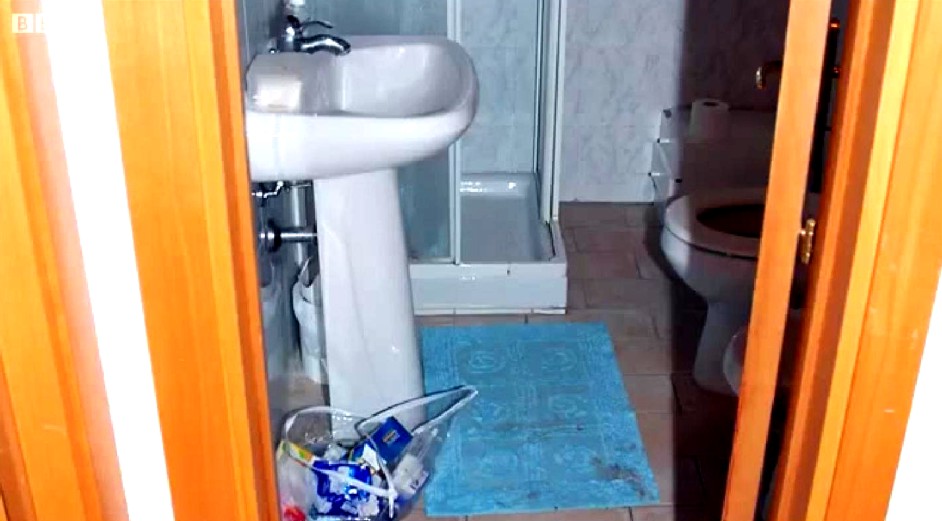
[Please click on each image for a larger and more high-resolution version]
The sheer depth and width of the hard evidence
The defenses really don’t want you to know this: in both width and depth, the full panoply of the evidence against Knox and Sollecito is absolutely overwhelming.
As we remarked in our post below there are far more and far stronger evidence points than UK and US courts normally require for conviction. But only the trial panel of judges observed anything like their full array.
The 2010 Massei Trial Report (which the Nencini Appeal court validated this past January) is a SUMMARY of what was presented to the judges in the courtroom. Those presentations in court were in turn something of a SUMMARY of the hard evidence buried in all the evidence files and the minds of witnesses.
Italian media SUMMARISED for Italians what was to be seen in the courtroom and to be read in the Massei Report. They were barely able to do even summaries for the 1/4 of all the trial hearings that were not open to the media or the public.
UK and US media for the most part didn’t even bother to provide comprehensive summaries (the very fine on-the-spot reportings of Andrea Vogt, Barbie Nadeau and Ann Wise were the main exceptions).
So in effect people in the UK and US attempting to follow the story didnt for the most part receive even a summary of a summary of a summary!
Not one US or UK newspaper or TV network translated the Micheli Report, or the vital Massei Report, or the Supreme Court appeal, or the Supreme Court outcome - only the (mostly professional) translators on PMF dot Org did all that translation.
This post is another example of how far down - beyond even Massei - it’s possible to drill into the evidence, and see it still hold up.
Some past posts on TJMK drilled down to similar depths, on the knives, on the DNA, on the mixed-blood traces, on the phone-events, on the motives and psychologies, and so on. All that evidence too all held up.
Visual analysis of the bathroom-mat footprint
This post mainly consists of high-resolution pictures and measurements. Presented like this, the pictures and measurements largely speak for themselves, and show the real strength of the bathroom-mat footprint evidence.
You will see that as SomeAlibi previously concluded using other methods, this footprint was quite undeniably Sollecito’s. It bears no similarity at all to Rudy Guede’s.
Please click on all images for larger versions in scalable PDF format
1 . [Below] the bathmat and the print, with measurement reference
2 . The bathmat print and the surrounding area
3 . The bathmat print (photo from Polizia Scientifica).
4 . The bathmat print, with vertical and horizontal sizes, from Rinaldi’s report
5. The bathmat print, photo with enhanced contrast.

The photo above was modified by highly enhancing contrast.
6 . Enhanced contrast helps to spot some features
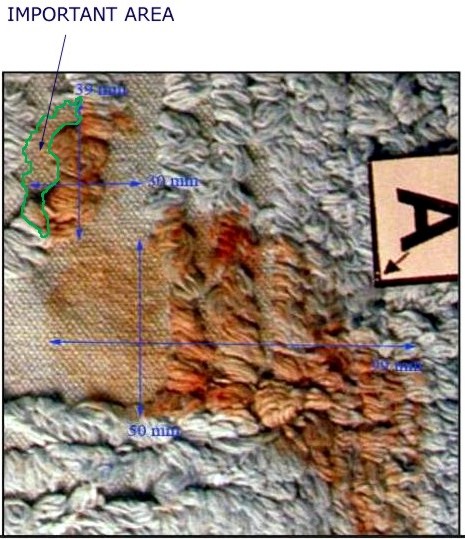
Contrast may help to highlight especially some parts of the print outline.
For example the area on the left labeled as “important area” in the picture (which was “forgotten” in the notorious photo elaborations disseminated by the ‘Friends of Amanda’ group), shows the actual left outline of the “˜big toe’ of the bathmat print.
The toe includes the area indicated in this picture (here the picture is shown again in its original colours).
7. The bathmat, with enhanced contrast
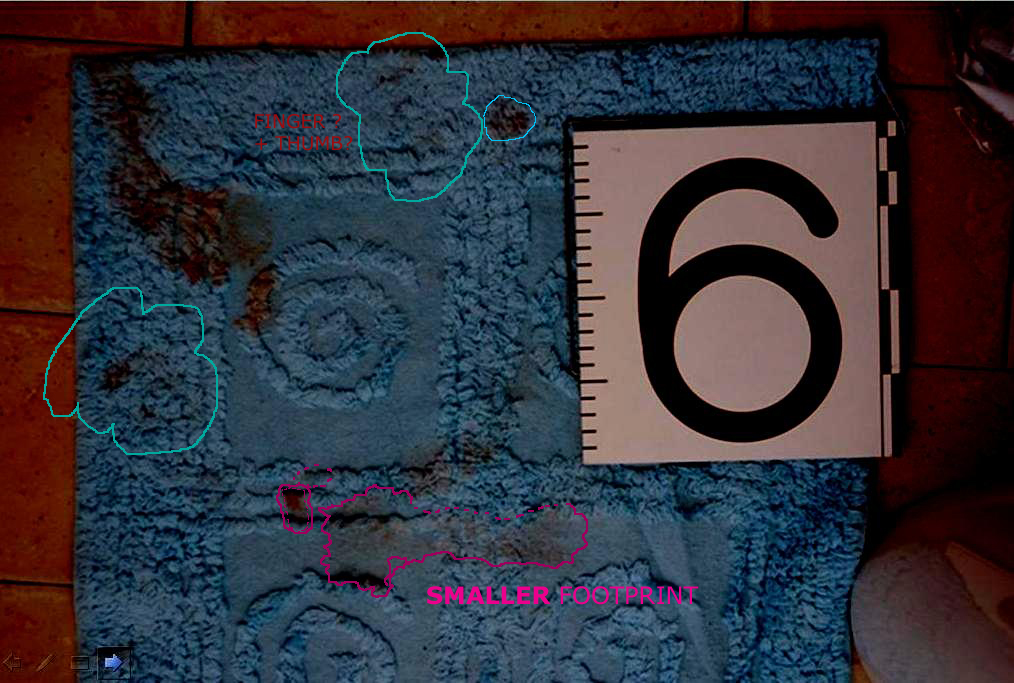
The contrasted image is showing the presence of other stains
There are other stains on the carpet (about another 10, factually situated in one half of the mat area), and also there shows a second diluted footprint (apparently from a foot of smaller size).
8. The selection of a set of red colour shades, outlined by an automatic outline generator
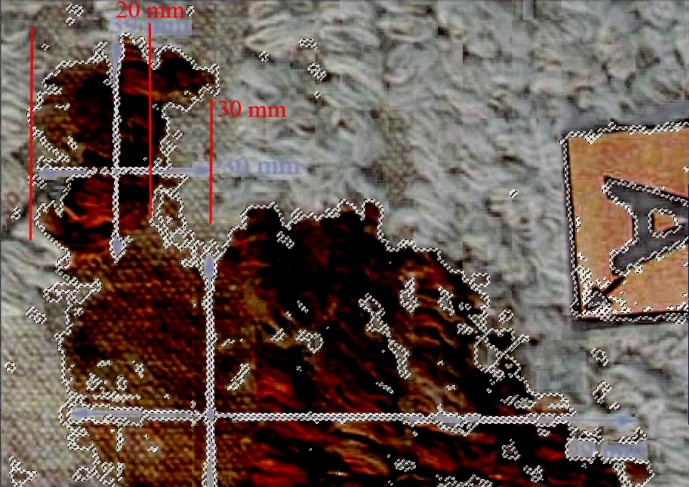
Shows the shape and the possible “˜outline’ of the stain
Reference measurements indicate the width of the “˜big toe’ in millimetres.
9 . A hand drawing of the outline (detail).

The photography above was modified
The modifications are: +28% contrast, -8% luminosity, + 20% colour saturation, from the original.
An outline has been drawn manually on the photoshop image, trying to be as faithful as possible to the actual stain.
You can notice that, apart from some minor “˜disputable’ very faint areas (such as the area between the toe and the metatarsus) there are only minimal differences between an automatically generated outline and a manually drawn one.
The shapes of the “˜big toe’ are extremely similar in both contours (images 8 and 9), in fact all meaningful features are basically identical.
We consider this manually drawn outline as good for comparison.
10 . The complete hand-drawn outline
11 . Minor detail: small dots separated from the main stain

Observe the small red ‘dots’ in the picture above
Although we can’t draw any conclusion about their possible significance, we note the existence of these very small “˜spots’ of a faint red colour shade, separated from the big stain.
They are detected by the computer generated outline above, and that we also see as distinguishable with the naked eye thus we considered them in drawing manually the outline.
We don’t draw any conclusion about them; but because of their sensitive position (they may suggest a “˜small toe’ mark) we take note of them.
The green arrows in the picture point out their position (green circles).
12 . An image in electronically modified colours
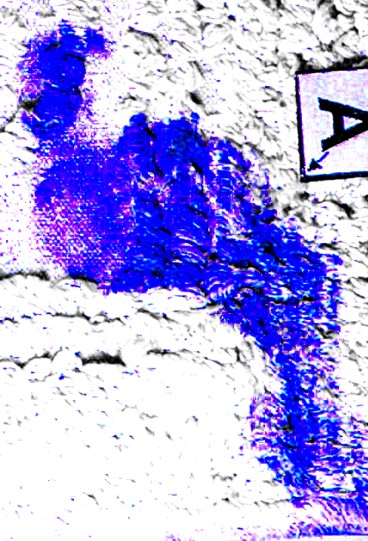
Distribution and intensity of the colouration
As a part of the preliminary study of the stain, we also produced this image above where the computer assigned an artificial colour to an array of shades of ‘red’, thus allowing to further isolate the stain from the background for further assessments about its shape.
This picture shows the distribution and intensity of the colouration. (note: the existence of some above mentioned tiny marks is recorded by this technique too)
13 . The bathmat has a spiral-shaped relief decoration
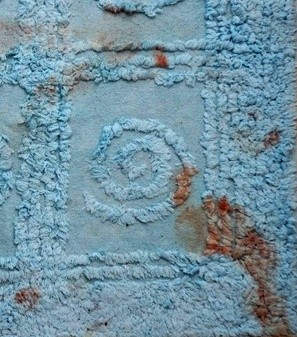
The footprint’s toe obviously balancing on top of the relief decoration.
We think the outline of the “˜toe’ mark of the bloody footprint is affected by the shape of the decoration, in particular the missing part of the toe on the right side, which is remarkably coincident with the margin of the decoration.
So that on that side there is a striking correspondence between the outline of the “˜negative area’ ““ the fabric surface around the spiral, which is lower ““ and the big toe’s outline
This indicates that the outline of that mark on that side was affected by the decoration margin, thus the print there has a “˜missing part’. So the “˜crooked’ bloody area in fact follows the margin of a larger toe.
Because of such coincidence, we can logically assume that the actual shape of the big toe mark appears to be part of a big toe, with larger surface which left its print only partly because part of its surface did not have contact with the fabric, in correspondence of the “˜negative area’.
14. The “negative area”
15. Mat decoration in relief and the toe mark
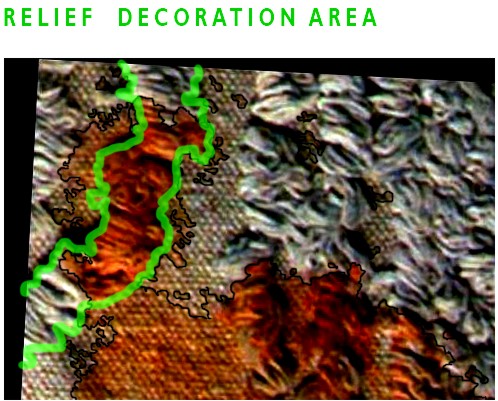
Observe above one single, unitary stain
The remarkable coincidence between the outlines of the decoration in relief and of the toe mark is shown in the picture above.
The rough contour of the print obtained through a smooth curve highlights the shape of the big toe.
Part of the relief decoration outline coincides with the toe mark outline, which shows, highlights and explains how all parts of the red toe mark, that you can see left of the relief decoration, they all belong to one single, unitary stain.
Thus we can deduce that the “missing” area on the right of the toe is determined by the decoration, and coincides with the negative area.
16. Picture (by Kermit) showing a rough shape of the stain
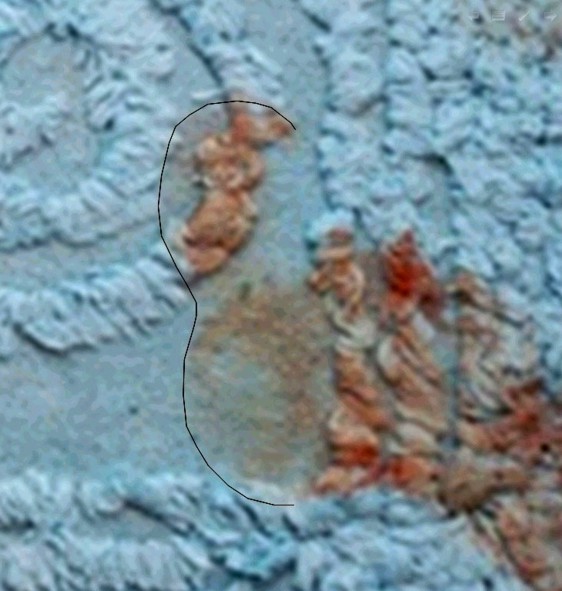
Observe shape, curvature and size
This drawing by Kermit above highlights the rough shape, curvature of left margin and overall size of the big toe.
17. Rudy Guede’s sample print
A copy of this picture together with one of Sollecito’s print at the same scale will be used for comparisons.
18 . Raffaele Sollecito’s sample print
A copy of this picture together with one of Guede’s print at the same scale will be used for comparisons.
19. Part of Rudy Guede’s sample print with Rinaldi’s reference measurements
20. Part of Sollecito’s sample print, with Rinaldi’s reference measurements:
21. Bringing all photographs down to the same scale
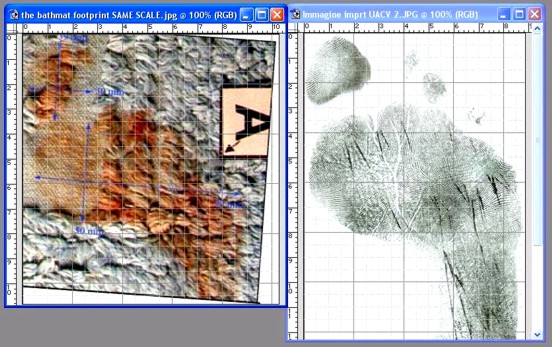
An accurate exercise of scaling was done
This was based on Rinaldi’s referenced pictures. Each one of the Rinaldi’s sample pictures has multiple measurements on several points of reference which allow a high precision determination of their scale and sizes, and thus comparison at the same scale.
In order to further increase scaling precision, the scale was calculated previously and separately for each comparative measurement in the three photos; this was done multiple times for each measurement and the average was picked in order to reduce error as for statistical measurement method.
The resulting final error in the scale is extremely small, far below a threshold of significance that could affect comparison (which was set arbitrarily at 1%, but it’s probably significantly higher, while the actual error is much lower).
In other words, the scale error that may affect your screen pictures will be definitely smaller than any possible perceivable (either significant or tolerated) difference that would be noticed or that may affect the attribution of the stain, when this is compared to the sample.
22. The hand drawn outline is shown again here
23 . The outline (matched scale) overlapped on Sollecito’s sample footprint
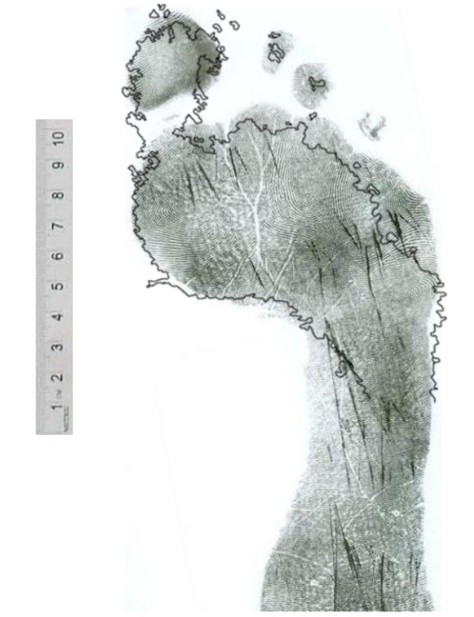
The array of compatibilities with Sollecito
The bathmat stain does not seem to have major incompatibilities with Sollecito’s print; it shows rather an array of compatibilities that can be perceived visually.
One interesting feature is the shape, size and position of a ‘big toe’, that appears as a remarkable coincidence; the toe also has a kind of cleft (see 28 below) on the curvature of its left margin. Another outstanding coincidence is the curvature of the plantar arch on the left.
24 . The same outline overlapped on Guede’s footprint
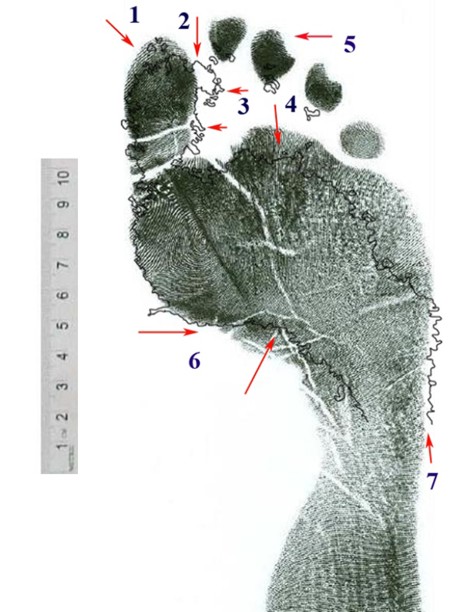
Compare with Guede’s - matched scale.
If you look at the overlapping of the stain outline (see pic 22.) with the sample of Guede’s print (see pics 17. 19.), you may notice 7 major differences, showing a failure of compatibility. Those differences are indicated by numbers (1-7) in the picture .
Each one indicates an area of major difference between the outline of the bathmat stain and the outline of Guede’s sample print. Those measurement differences are remarkably larger than those that can be detected on the overlapping with Sollecito’s sample print.
On the other hand, the compatibility between Sollecito’s print and some very peculiar aspects of the bathmat print (such as a 30mm wide and short toe) were absolutely remarkable.
The differences between the bathmat stain and Guede’s print are :
1) Toe mark of stain is significantly SHORTER than the big toe in Guede’s sample print (a difference of about 7 millimetres). Some people may want to attempt an objection, by suggesting that such a difference may be just a consequence of the position chosen for the overlapping, that maybe the bathmat print was just positioned too low in the picture, the problem may be solved by shifting it up about 7 millimeters so as to make the tip of the bathmat toe ‘coincide’ with the tip of Guede’s print toe.
However, such objection wouldn’t work; it’s a wrong argument. In fact the only possibly correct position for overlapping the bathmat stain outline is determined by the left curvature of the ball of feet and plantar arch (the area of the picture near number 6), which is by the way the most clearly outlined part of the bathmat stain. If you shift the bathmat stain upwards, the outline will miss the match with the curvature of the left margin of the ball of the feet. You will notice that the plantar arch in this area is already very incompatible with Guede’s plantar arch. It tends to become even more incompatible the more you shift the bathmat stain outline towards the toe.
The problem has no solution, since the more you shift the stain outline upwards (in the direction of the toe) in an attempt to make it look more ‘compatible’ with the length of Guede’s toe (or with an upper margin) the more it will become incompatible with the plantar arch. In order to limit the incompatibility of the plantar arch, and in order to keep an overlapping of at least the left margin of the ball of the feet, you need to place it as shown in the picture, this is the position of ‘maximum’ compatibility between the bathmat stain and Guede’s print. Conclusion: the bathmat toe is too short.
2) Toe mark of stain is TOO WIDE (30 mm). It is much wider (30 mm) than Guede’s toe. The number 2. indicates the protruding mark at the upper right, the mark which Giulia Bongiorno desperately insisted on calling a “second toe” mark. In fact, not only would the mark miss completely any hypothetical Guede’s ‘second toe’ in any possible position of the print; also you may notice (highlighted by pics 8. and 9.) how it is not a “mark” itself, but actually it just part of the same area which is entirely continuous in shape and coloration with the rest of the toe mark, and - the most remarkable feature - its right outline is coincident with the outline of the spiral-shaped relief decoration, so that you can reasonably conclude that it is determined by that (the missing area at the lower right of the ‘big toe’ is determined by the existence of the “negative area” of the bathmat decoration).
Conclusion: the bathmat stain has a wider toe mark, however one likes to call it (“big toe”, or “big toe + second toe”) that fails to match any possible part of Guede’s print. The bathmat print is clearly different and incompatible with Guede’s print. It simply cannot be overlapped to any part of Guede’s sample print. Such area is a very significant difference that points outright to incompatibility between the stain and Guede’s print.
3) The toe mark is larger also in the area located at the lower portion of the toe. The toe of the bathmat print in fact has a ‘right margin’ which actually has some additional small marks, small drops protruding towards the right, like droplets maybe produced by the wet cotton fibres of the part in relief which protrude towards the right. This tends to suggest the toe area of the stain may in fact be considered wider: the object that produced it was definitely wider than 22mm, in this area of the toe as well. So also a look at this area confirms that the bathmat stain is wider than 22-23 mm (more towards 30 mm) not just when measured at the upper corner (number 2.) but also at its “lower” parts; here, the small marks caused by the liquid suggest that a larger surface has squeezed liquid from some fabric threads leaving some trace also on the lower area.
4) Bigger incompatibility of Guede on the metatarsus front outline. This area is the front outline of metatarsus: the stain is almost 1cm shorter than Guede’s metatarsus. This happens when you chose the overlapping so as to make the left outline and plantar arch (6.) of metatarsus coincide, as in the picture. Sollecito’s sample print also shows some difference from the stain in this area (pic. 23.) but the difference between the stain and Sollecito’s print is significantly smaller than what you can see in Guede’s print.
5) There are NO SMALL TOES in the bathmat stain. Small toes are completely absent from the bathmat stain (while the tiny blood marks around the stain don’t coincide with their expected position if it was Guede’s print). Such lack of small toes is a peculiarity of the bathmat print. This is a remarkable difference from Guede’s print, and at the same time, a considerable analogy with Sollecito’s print. In fact one outstanding feature of Guede’s print is the evidence that Guede places a big load of weight on his small toes while instead Sollecito has a posture with a weight distribution with the contrary tendency, and obviously he almost does not touch the ground with his small toes.
Thus, Guede’s small toes are all very well pressed on the ground and thus, we can reasonably infer they are somehow naturally likely to get wet if he steps on any wet surface, and anyway they should get wet for sure if the foot is immersed in water or washed (the foot that left the bathmat print must have been immersed in bloody water). The murderer supposedly washed his foot then stepped on the bathmat. In order to attribute the print to Guede we should assume that Guede “forgot” to touch the carpet with his small toes (while instead he puts a lot of weight on them) or that he managed to not rinse them.
6) The outline of the stain has a PLANTAR ARCH that COINCIDES, by curvature and angle, with the plantar arch in Sollecito’s print, while instead it is very different from the plantar arch of Guede’s print.
7) The stain is larger than Guede’s print metatarsus as visible in the right area of the stain. The difference is rather significant, almost half a centimetre, that is bigger than the difference with Sollecito’s print which instead coincides for a trait. This difference cannot be “solved” in any way since, even if one wanted to claim that the scale is wrong and that the stain should be sized down, this would make the toe, already too short (as in 1.) become even shorter.
If instead the toe length is adjusted the metatarsus becomes even less compatible with Guede. We recall that Massei found that Guede’s feet had a print overall more slender than Sollecito’s.
25 . Other features:
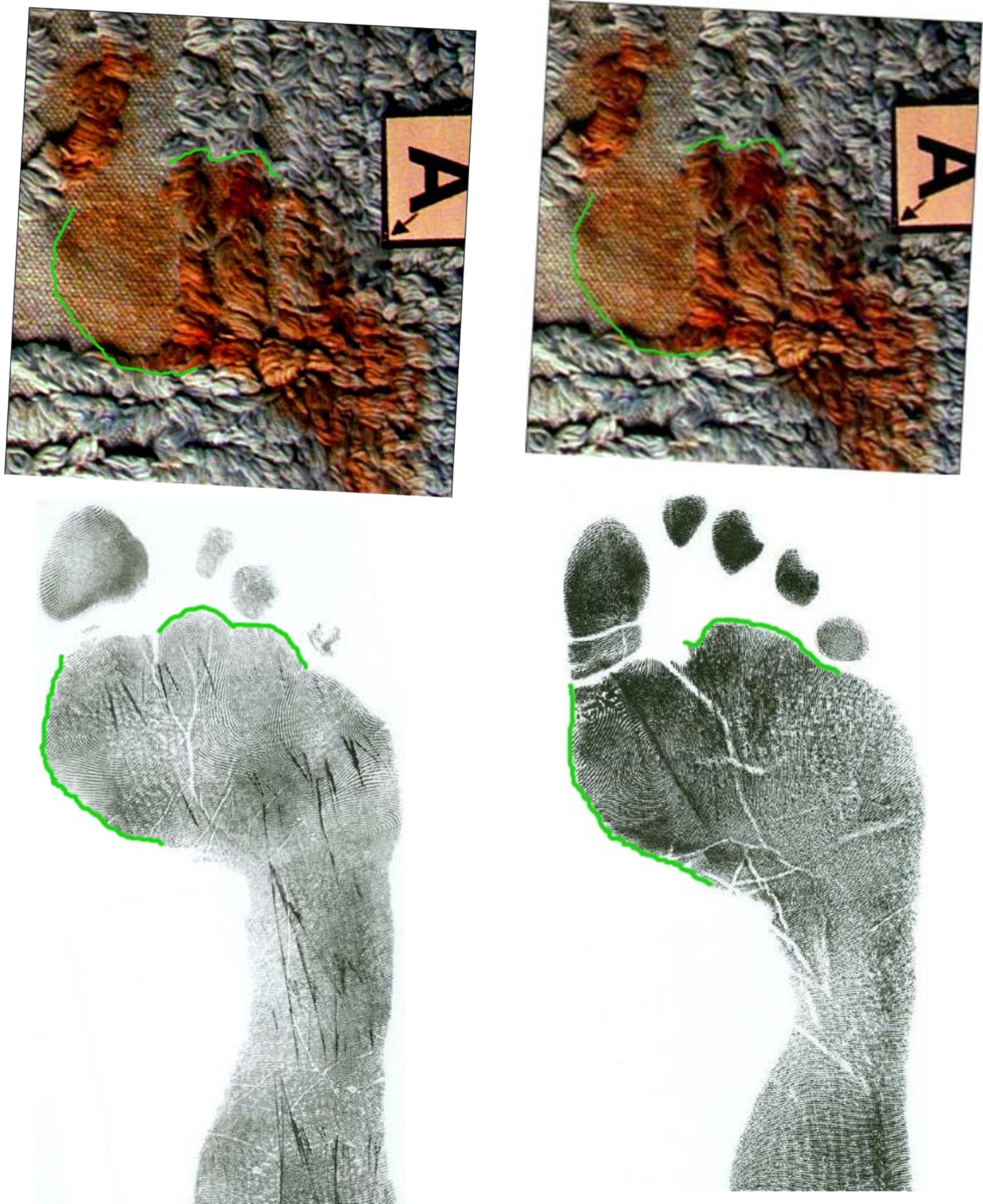
Curvatures of plantar arch are very different
The plantar arch curvature, highlighted in two different drawings (the second highlights also the upper outline “hunches”); the plantar arches in the two sample prints of Sollecito and Guede are shown below. The curvatures of plantar arch are very different.
26. The outline curvature generates different angles
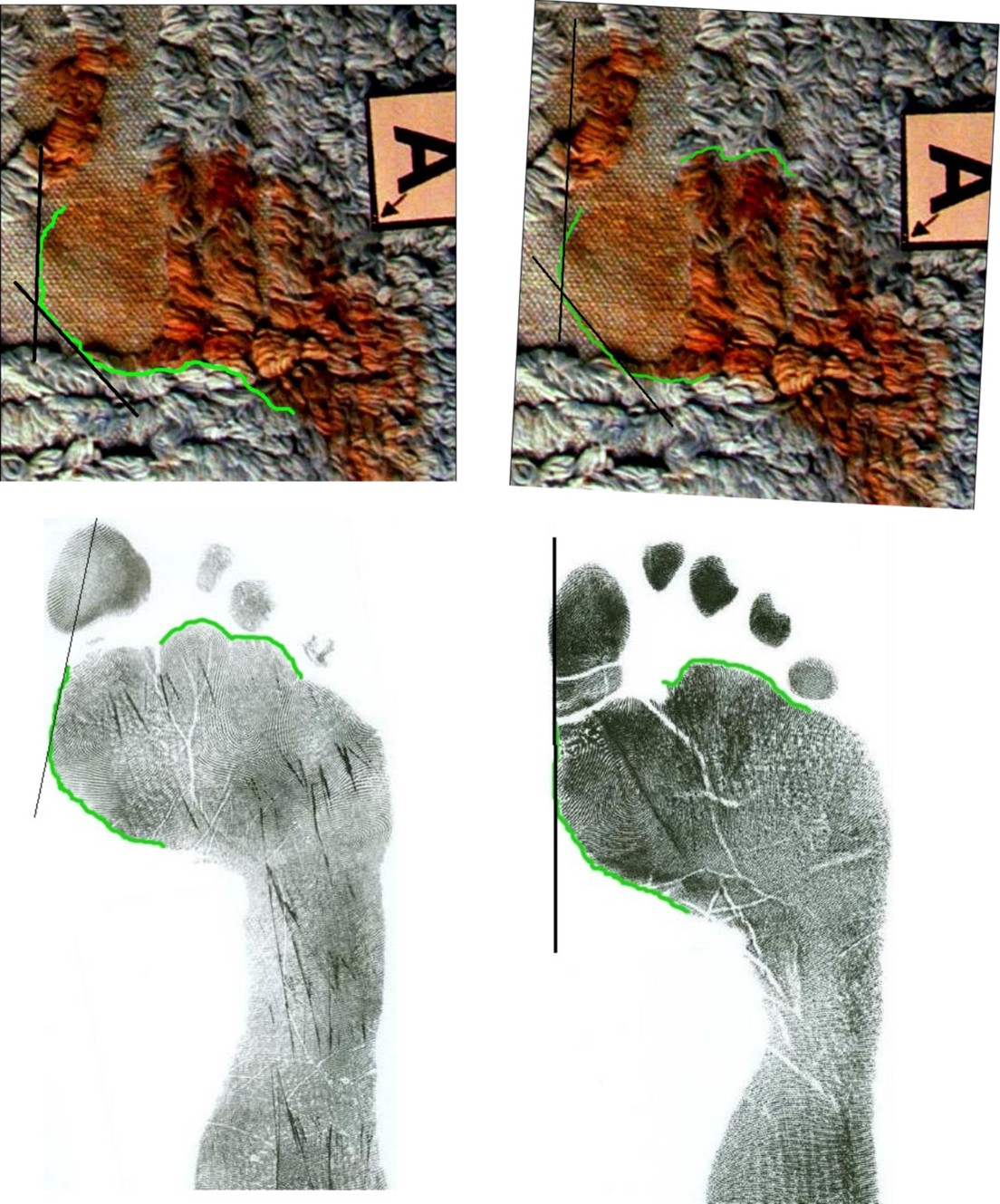
Sollecito’s and Guede’s plantar arch curvatures have very different angles. Also the left outline of metatarsus maintains a different curvature. Sollecito’s outline has an angle (see outline tangent) intersecting the toe (the metatarsus has a “bunion”); in Guede’s print there is basically no intersection, the outline and the toe form almost a straight line.
27 . Plantar arch curvature angle differs between Sollecito and Guede
If you consider the vertical axis of the sample footprint, and its orthogonal line, you may notice how the plantar arch curvatures of the two prints accomplish different angles: the two angles are VERY different, not just three or four degrees.
The (too) narrow angle of Sollecito’s plantar arch probably has a relation with the protruding outline and angle seen in pic 26., and seems related to a hallux valgus (which Guede does not have).
28 . The “cleft” on the left side of the stain
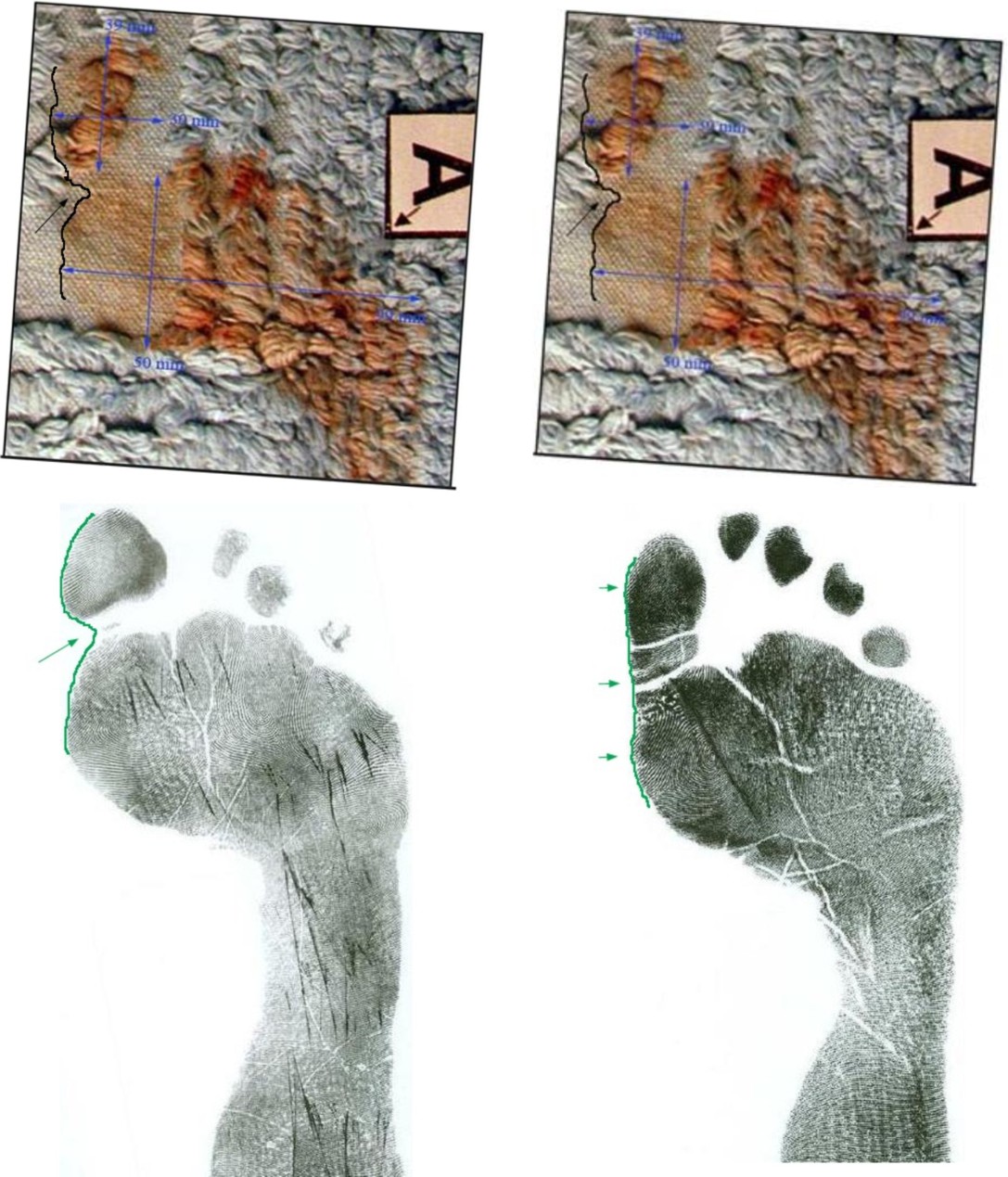
The “cleft” on the left side
This has a correspondence with one sample print, not so with the other.
29 . Table of metric comparison (by SomeAlibi)
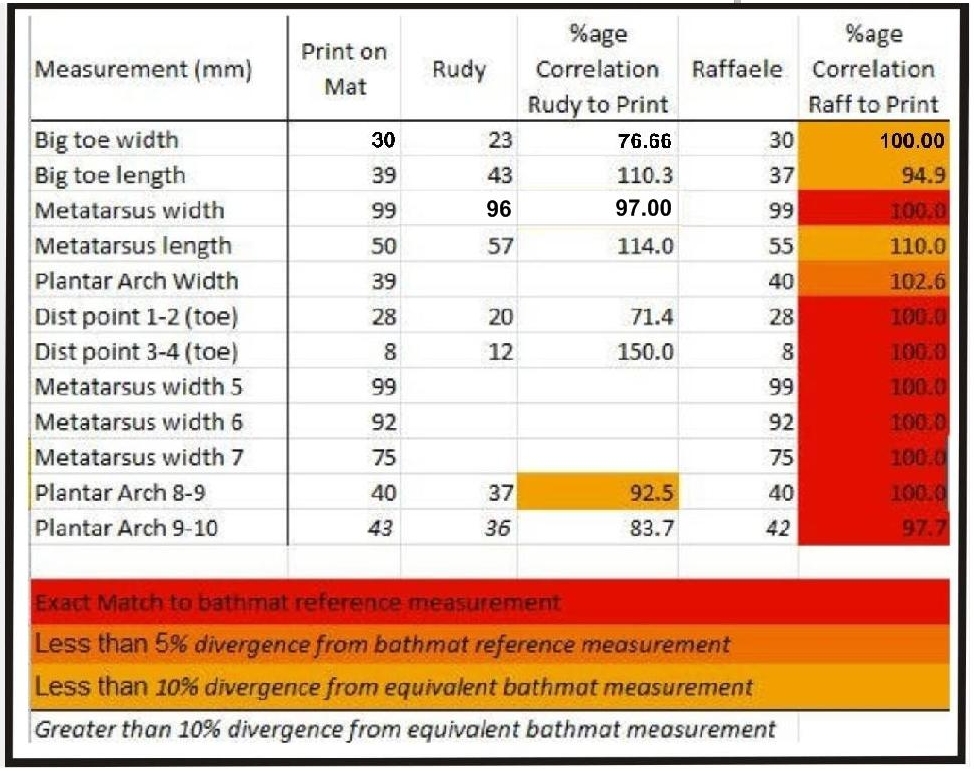
SomeAlibi’s post of a year ago
Comparison of measurements and analysis of correspondence degree of bathmat print, with both Guede’s and Sollecito’s sample prints.
Thursday, April 10, 2014
Sollecito Takes On A New Lawyer To Help Him Work His Way Past The Minefield That Is His Book
Posted by Peter Quennell

Raffaele Sollecito retained Alfredo Brizioli after he burned his trial lawyers in his book
Both Sollecito’s book and Knox’s book seem to have the primary purpose of poisoning public opinion against the courts.
The serious charges Sollecito and Knox will probably face for those books are of three kinds: (1) the contempt-of-court misrepresentation of the Italian justice system itself; (2) the obstruction-of-justice twisting of the evidence in the case; and (3) the claims of crimes committed by numerous career police and prosecution officials.
If false, in effect a gigantic frame-up that leaves Knox’s framing of Patrick in the dust.
At the eighth session of the Florence appeal court back in January, Giulia Bongiorno engaged in a day-long summation which was peculiar, to say the least.
Like Sollecito and Knox in their books, Giulia Bongiorno seemed to be attempting to put the justice system and investigation and prosecution in the dock.
If false, another gigantic frame-up that leaves Knox’s framing of Patrick in the dust.
Bongiorno’s rant didnt seem to help Sollecito in undermining any of the hard evidence in the case, and it left the judges visibly unmoved. But it was notable how closely it resembled the rants on the justice system and its officials by Sollecito himself in his book. See the examples in the post below.
There are some complex later passages in Sollecito’s book and some recurring themes that we will analyse which would seem impossible for Sollecito to write about in such detail without the extensive help of a lawyer who was in the court.
Who precisely was that?
Reports from Italy now state that Alfredo Brizioli, not Giulia Bongiorno, will be the lawyer the Sollecitos choose to respond to the investigating prosecutor’s report on the book. Perhaps Mr Brizioli (who right now is himself on trial for obstruction of justice in another case) can try to negotiate a way for his client to spread the blame before the charges are set in stone.
The Sollecitos seem weak. Alfredo Brizioli seems weak. Giulia Bongiorno seems weak. And Knox also seems weak - if Sollecito is ever going to back away from Knox (perhaps to try to claim the final murderous stab of Meredith was solely Knox’s crazed idea) there is just this one last chance.
We in no way favor Sollecito getting off lightly without recanting. We do want to point to the potential fireworks a smart prosecution has engineered that might help achieve this.
Although there was a sort of bidding war for both books, not every publisher, having seen what was to be in them, was eager to join in. Some did sit on the sidelines.
Withdrawing the two books ASAP might be the smart move. The mood in the book industry in New York, where both publishers have their HQ’s, seems to be that that move could be the wisest.
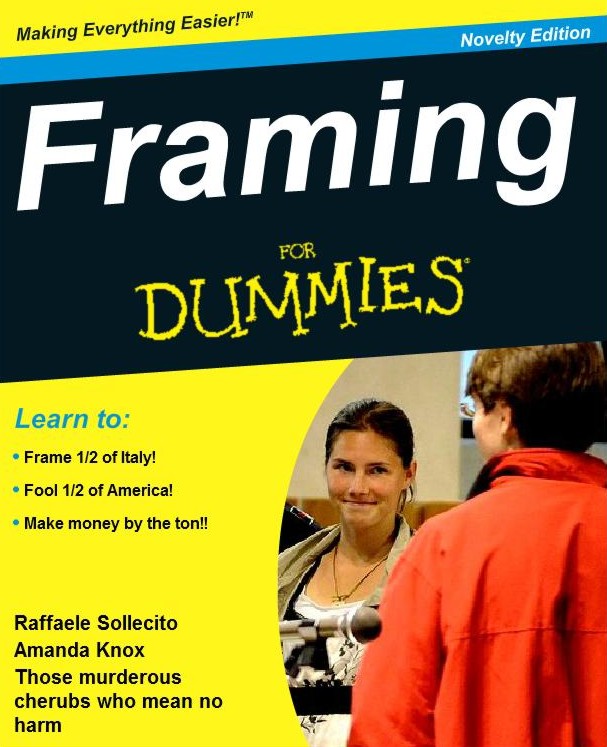
Monday, April 07, 2014
Italy Pushes Back On False Claims In Sollecito Book: 20 Examples Of What He Must Defend In Court
Posted by Our Main Posters
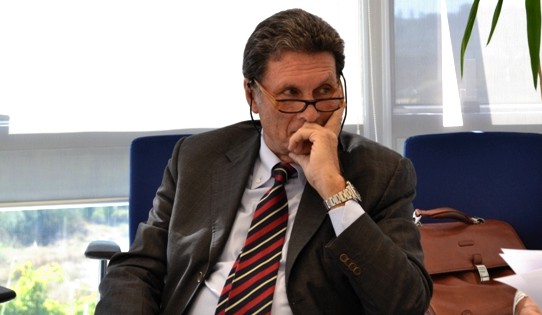
[Florence prosecutor Gianbartolomei will announce RS charges later this month]
Many posters contributed to this analysis and to what is to come. Special thanks to James Raper and Sara, and also to Vivianna, Yummi and Kermit.
1. Sollecito’s blood-money book gets published
Sollecito’s hapless book Honor Bound was released in English on 18 September 2012.
Within ten days all of Italy knew that the book was a crock.
Bruno Vespa, the persistent host of Porta a Porta, Italy’s most popular crime show (for the equivalent of which American TV cries out) forced Sollecito’s father in national prime-time to admit that at the core of the book was a huge lie.
Other claims about the case and the officials were shown to be wrong too.
Smarter people than Sollecito’s help in the US (Andrew Gumbel and Sharlene Martin, later John Q Kelly, and Simon & Schuster) might have put the brakes on until they got the truth straight and a revised version out.
But no, a media blitz was all ready to roar. The blood-money couldn’t wait.
Huge numbers of professional book reviews and Amazon reader reviews swallowed Sollecito’s claims in the book whole. The nastiness toward Italy and its justice system and officials was ratcheted onto a whole new plane.
2. Needless to say, official Italy did take note
For the legal reasons explained in this key post an investigation by the Florence Chief Prosecutor’s Office was mandated to begin.
In that same post it was warned that for the period the investigation would require, it would be taken below the radar, so that the Sollecito defense team would have no way to respond through dishonest PR or legal dirty tricks.
A not-unsurprising result of that stealth move was that in the meantime, in the last year, very full of themselves and feeling no constraint, Sollecito and his team went hog-wild in adding more crazy claims. And still more.
3. Now the investigation is complete
Now Prosecutor Gianbartolomei has issued his announcement of the conclusion of his investigation. The content of the notice is at present confidential except to the defenses.
As Yummi reports, from this point on, the defense has 20 days to say something, such as to request that Sollecito be interrogated or allowed to declare or explain something.
Then the prosecution will file charges against Sollecito and Gumbel, and possibly Sharlene Martin and Simon & Schuster, their careless publishers in New York.
Which precise false claims Prosecutor Gianbartolomei has made the target of his report we do not know. But this is a target-rich environment, that is for sure:
Consider for starters these 20 false claims which, believe it or not, all appear in the first seven pages of the book.
4. Twenty False Sollecito Claims
1. That Italian justice authorities took the easy way out
This is the story of two ordinary people who stumbled upon an extraordinary circumstance, the brutal murder of a British student in Italy. Neither Amanda Knox nor I had anything to do with the crime, but we came perilously close to spending the rest of our lives in prison because the authorities found it easier, and more convenient, to take advantage of our youth and inexperience than to mount a proper investigation. It’s that simple. And that absurd.
No advantage was taken of them. The two stood out very sharply from all the others of similar age, and of similar inexperience (whatever that means). They did and said dozens of things in the early days that set them sharply apart.
They were interrogated quite fairly, the Italian media was not especially hard, Dr Mignini never ever leaked, and they had lawyers and family handy at every turn after they were arrested. They each gave the authorities less than zero help - they tried to lead them off on wild goose chases, for example the false claim AK made against Patrick and dozens of other false claims, and apparently tried to finger yet another north African, Hicham Khiri, in a conversation they clearly knew was being recorded.
A “proper” investigation was indeed done. Simply read through all the posts on the trial here in the first half of 2009, and the prosecutor’s excellent summations, and you will see what a smooth comprehensive job was done. And the Supreme Court concluded that THREE had to have been involved, from the recreation of the attack and all the wounds on Meredith’s body. AK and RS and their lawyers never came within light-years of throwing real suspicion on anyone else.
2. That the preventive custody was very harsh
On November 1, 2007, Amanda and I were carefree students at the beginning of a cross-cultural love affair in a beautiful Umbrian hill town. Within days, we were thrown into solitary confinement in a filthy prison, without access to lawyers or loved ones, accused of acts so heinous and disturbing we may never be able to banish them from our thoughts, or our nightmares.
Raffaele was sent to preventative prison on Tuesday November 6. Capanne Prison was almost brand-new then, and far from crowded. Cells contain TVs and private bathrooms.
All questioning had been stopped early on 6 November until Sollecito could have a lawyer present. He himself wrote to his father in his “prison diary” on November 7: “I may see you tomorrow, at least that is what I was told by Tiziano [Tiziano Tedeschi, his lawyer at the time], who I saw today and who defended me before the judge.”
Mr Tedeschi made no complaint about any delay in the first meeting with his new client. In Italy, a judge must determine within 48 hours whether to hold or release detained suspects. Judge Matteini did so meticulously and refused his release.
3. That the prosecution and Italian media demonized the pair
In the newspapers and on the nightly news, we were turned into monsters, grotesque distortions of our true selves. It did not matter how thin the evidence was, or how quickly it became apparent that the culprit was someone else entirely. Our guilt was presumed, and everything the prosecution did and fed to the media stemmed from that false premise.
In the real world, the prosecution fed nothing at all secretly to the media and publicly very little, none of it self-servingly biased. Italian reporting was sporadic and very mild compared to anything one can see said daily about possible perps in the US and UK newspapers and on US TV. Besides, any coverage, which was in part deliberate in the situation as dozens of students were fleeing Perugia, had no influence on anything, neither on the investigation nor the trial.
The Italian system is set up so media can have less influence than almost any other media on any other justice system in the world. The Micheli and Massei sentencing reports show the judges were not unduly influenced even by the lawyers right in front of them, let alone by mild media reports 1 or 2 years before that.
4. That four years were wasted showing where the prosecution went wrong.
By the time we had dismantled the case and demonstrated its breathtaking absurdity [in the annulled Hellmann appeal] we had spent four of what should have been the best years of our lives behind bars.
“We” meaning the defense lawyers did very little in the annulled Hellmann appeal that they hadn’t flailed uselessly against in the trial. Except of course maybe shopping for an inexperience and pliable judge, and for DNA consultants who they could then spoon-feed. Much of the hard evidence they simply kept well away from in the trial and annulled appeal. Such as the extensive evidence in the corridor and bathroom and Filomena’s room, which were all considered parts of the crime scene.
On the other hand, RS’s claim could well apply to what Dr Galati and Cassation did for the Hellman sentencing report. Dismantled the appeal verdict, and demonstrated its breathtaking absurdity.
5. That Knox was made a target because timid Italy was scared of her.
Amanda and I certainly made our share of mistakes. At the beginning we were too trusting, spoke too frivolously and too soon, and remained oblivious to the danger we were courting even after the judicial noose began to tighten. Amanda behaved in ways that were culturally baffling to many Italians and attracted a torrent of gossip and criticism.
An inaccurate and xenophobic remark originated by the American Nina Burleigh, who was having severe culture shock of her own and surrounded only by other foreigners with similar mindsets. What EXACTLY was so baffling about Knox to the very hip Italians? That Knox was pushy, obnoxious, humorless, rather lazy, rather grubby, and not especially bright or funny or pretty? That she put off Patrick, Meredith, her other flatmates, the boys downstairs, the customers in the bar, and just about everybody else except for the distasteful druggie loner Sollecito?
Read this post by the Italian-American Nicki in Milan. To quote from it “As many of us were expecting, Amanda’s testimony has backfired. She came across not as confident but arrogant, not as sweet but testy, not as true but a fake who has memorized a script, an actress who is playing a part but not well enough to fool the public….. Amanda Knox is not on trial because she is American and therefore too “emancipated”....Italians don’t much like Amanda primarily because they perceive her as a manipulative liar, who is suspected of having committed a heinous crime for which there is a whole stack of evidence.”
6. That Knox and Meredith were really great, great friends.
We were young and naive, unthinking and a little reckless. Of that much we were guilty. But what we did not do””and could not have done, as the evidence clearly showed””was murder Meredith Kercher.
Meredith was Amanda’s friend, a fellow English speaker in the house they shared with two Italian women just outside Perugia’s ancient city walls. She was twenty-one years old, intelligent, and beautiful. She and Amanda knew each other for a little over three weeks, long enough to feel their way into their new surroundings and appreciate each other’s interests and temperaments. I never heard about a single tense moment between them.
Plenty of other people did know of tensions. Meredith’s family and friends all knew Meredith was finding the noisy dirty lazy loud unfocused Knox and her one-night-stands hard to take. Her other flatmates found her hard to take. Her employer Patrick found her hard to take. His customers in the bar found her hard to take. The Lifetime movie got this strident angle pretty straight.
Remember, Meredith enrolled for a full academic load at the main university. Knox in sharp contrast took only one undemanding language course - which anyone could walk into - requiring maybe 10 hours of study a week. They increasingly did less together. In fact after several weeks nobody was lining up to have anything to do with Amanda Knox.
Seemingly unable to reverse herself, she was headed to being among the least popular of students in Perugia. It should be recalled that the callous remarks by Amanda Knox about the death of her so-called friend Meredith included “Shit happens”, “She fucking bled to death”, and “‘I want to get on with the rest of my life”.
7. That an intruder knew about the rent money and so murder ensued.
Meredith, of course, suffered infinitely worse luck than we did: she came home, alone, on an ordinary Thursday night and had her throat slit by an intruder hoping to steal the household rent money.
There is zero evidence that this was the case. Knox herself ended up with a similar amount of cash that she has never been able to explain. There is zero possibility that Guede would know that any money was lying around - or not lying around, as it was concealed in Meredith’s drawer.
And take a look at the many images of the brightly lit house at night. There are several dozen other houses behind it in the dark which any smart burglar would have chosen first. In 2008 two real break-ins occurred at the house - both were in the dark behind the house, which is by far the easiest place to break in.
So much for the spurious lone-wolf theory, which Judge Micheli first ruled out even before trial.
8. That the media got hysterical and portrayed heartless killers.
But the roles could easily have been reversed. If Meredith’s Italian boyfriend had not gone away for the weekend and if Amanda had not started sleeping over at my house, she””not Meredith””might have been the one found in a pool of blood on her bedroom floor. That reality was quickly lost amid the hysteria of the media coverage. But it continued to hover over both of us””Amanda especially””as we sank into the legal quagmire and struggled in vain to overcome the public image of us as heartless killers.
There was zero media hysteria. This silly claim was addressed above. Watch the Porta a Porta YouTubes and dozens of other Italian reports and try to find ONE that is not fair and cautious and mature.
How precisely did the two struggle in vain to overcome their public image? By coming up repeatedly with stories which didnt even tally with others of their own, let alone with one another’s? They never between them made even one helpful statement which actually helped the police. And even their respective parents strongly suspected or knew of their guilt and were all caught incriminatingly on tape.
9. That Rudy Guede did it alone; ignore vast evidence that proves not.
This should not have been a complicated case. The intruder was quickly identified as Rudy Guede, an African immigrant living in Perugia with a history of break-ins and petty crimes. His DNA was found all over Meredith’s room, and footprints made in her blood were found to match his shoes. Everything at the crime scene pointed to a lone assailant, and a single weapon. Guede repeatedly broke into houses by throwing a rock through a window, as happened here, and he had been caught by the authorities in the past with a knife similar to the one that inflicted Meredith’s fatal wounds.
This is laughable. It has in fact been demonstrated in numerous ways that the attack involved multiple assailants and this was accepted by the Supreme Court.
Sollecito’s own lawyers never forcefully argued this. They produced two non-credible witnesses in the appeal trial (Alessi and Aviello) to actually prove that Guede had some other accomplices or that several others did it. Also Amanda Knox if anything diverted attention AWAY from Guede as he did in turn from her. He wasn’t quickly identified precisely because Knox had rather credibly fingered Patrick.
There is no proof Guede was an intruder. The trial court concluded Knox invited him in. Guede had zero proven history of break-ins or petty crimes or drug-dealing, and late in 2008 at his trial Judge Micheli became angry at such claims. Guede had no prior criminal record at all. He had only been back in Perugia for a few weeks, after an extended stay up north. His DNA was not found “all over” Meredith’s room. A major surprise, in fact, was how few traces of him were found.
The recreation of the crime scene and the autopsy both pointed AWAY FROM a lone assailant, not toward. From Meredith’s wounds, it was quite evident that two and perhaps three knives had been used, and not a single weapon. What lone intruder carries or uses two or three knives? And footprints in blood outside the door matched the feet of both RS and AK. This is why the Supreme Court confirmed Guede’s guilt only “in concorso” (with others).
10. That the cops could have caught Guede fast, despite Knox’s frame
Guede did not call the police, as Amanda and I did, or volunteer information, or agree to hours of questioning whenever asked. Rather, he fled to Germany as soon as the investigation began and stayed there until his arrest two and a half weeks later.
Guede’s apprehension and eventual conviction on murder charges should have been the end of the story. But by the time Guede was identified, the police and the public prosecutor’s office had convinced themselves that the murder was, incredibly, the result of a sexual orgy gone wrong, in which Amanda and I had played leading roles. Their speculations ignited a media firestorm, inspiring sensationalist headlines across the world about the evil lurking behind our seemingly innocent faces.
The authorities had no shred of evidence to substantiate this story line, only erroneous suppositions and wild imaginings. We had an alibi for the most likely time of death, and none of the initial forensic evidence tied us to the scene of the crime. Nothing in our backgrounds gave any hint of a propensity for violence or criminality. We were both accomplished, hardworking students known to our friends and families for our gentleness and even tempers.
Four more untrue remarks. All three were convicted of a murder with a sex-crime element and nobody was wrongly “convinced”. Which alibi is Sollecito talking about now? He himself admits in chapter 1 (Love and Death) that they had no “real alibi”. They still have no alibis at all for the second half of the evening, neither of them, when Meredith’s murder indisputably occurred.
Extensive forensic evidence within days tied them both to the scene. Not a single element of it has been discredited in the eyes of the Massei trial and Nencini appeal court. Not even one. Nothing was falsified.
Neither of their backgrounds was squeaky clean. Both had long been into illegal drugs, the loner Sollecito had to be watched by his father and teachers, the increasingly disliked Knox had a history of doing and saying crass off-putting things. Both were lagging behind their brighter peers in their studies and Knox was taking a year off.
11. That the prosecution fed the media a huge number of false claims.
Yet the authorities stuck to their guns. They fed the media a steady diet of sensationalist stories of how Amanda, the promiscuous American she-devil, and I, her sex-and-drug-addled Italian helpmeet, had tried without success to drag Meredith into our depravity and punished her by plunging an outsize kitchen knife into her neck.
Complete fiction. Again, in the real world, as the media reporters all confirm, the prosecution fed nothing at all secretly to the media, and publicly very little, none of it self-servingly biased.
Italian reporting was sporadic and very mild compared to anything one can see daily on possible perps in the US and UK newspapers and on US TV crime shows. There is zero sign this mild coverage mattered to the courts. As the media reporters all confirm, they were fed next to nothing by the police or prosecution on the case,
But whereas Mr Mignini famously never leaks, the defenses are widely claimed to have leaked throughout like sieves. So did Sollecito’s own family - they leaked an evidence video to Telenorba TV, for which they were considered for trial. Even we at TJMK and PMF received several offers of juicy leaks. Here is one example of where the Knox forces leaked - wrongly in fact - and then nastily slimed the prosecution and defenseless prison staff.
12. That the authorities had lots and lots and lots of scenarios.
It might have been funny if the consequences had not been so devastating. Listening to the tortured language of the prosecution””“one can hypothesize that . . . ,” “it is possible that . . . ,” “one can imagine that . . . ,” “this scenario is not incompatible with . . .”””it became clear that the authorities, like the media, were treating our case with the bizarre levity of an after-dinner game of Clue, or an Agatha Christie mystery. Everyone, even the judges in their black robes, had theories they were itching to air.
Have Sollecito and Gumbel ever before been in any other court in Italy or the UK or the US? Every judge and/or jury has to arrive at a scenario on lines not unlike this. That is the whole POINT of having courts - to weight the probabilities in what happened in the crime. The only difference in Italy is that the judges have to think their verdict through for weeks, and then write it all out, and then see it scrutinized by a higher court. This is hardly a requirement to be sneered at.
Gumble and Sollecito should have studied how US and UK juries arrive at their own scenarios. Very few US and UK lawyers think they do a better job. Ask those who watched the OJ Simpson and Casey Anthony trials and bitterly criticised the outcomes. And Italy has a vastly lower rate of false imprisonment than the US does.
13. That Italy is a medieval country with a primitive justice system.
It could have been Colonel Mustard in the drawing room with the revolver; instead it was Amanda and Raffaele in the bedroom with the kitchen knife. How was it conceivable that a democratic country known for its style and beauty and effortless charm””the Italy of the Renaissance and la dolce vita””could allow two young people to be catapulted to international notoriety and convicted of a horrific crime on the basis of nothing at all?
This is not remotely what happened. There was very far from nothing at all. Convictions in the US and UK regularly result based on evidence 1/10 or 1/100 of that here - sometimes from one single evidence point. Any one or several of maybe 100 evidence points here could have convicted them in a US or UK court.
Italy gives defendants every possible break, and the justice system is seriously loaded against victims and their families. Read here and here.
14. That the prosecutors office and media were in a grim embrace.
The answer has something to do with the grim embrace that developed between the prosecutor’s office and the sensationalist media. Like addicts constantly looking for the next fix, each fed the other’s insatiable appetite for titillation and attention. The casual cruelty of “Foxy Knoxy” and her Italian lover became too good a story line to abandon, even when it became apparent it was overheated and unsustainable. Our suffering was the price to be paid for the world’s continuing entertainment.
WHAT grim embrace? WHAT addicts? WHAT fix? WHAT insatiable appetite? WHAT titillation and attention? This is clearly defamatory if it can’t be proven, and we can turn up no evidence that any of it is true. It has to be one of the most foolish lies in the entire book, it is so easy to disprove. These who are being accused of crimes here are career police and prosecutors secure in their jobs, and none have the slightest gain to make from false convictions.
15. That in the justice system speculation and hearsay run rampant
The meandering complexities of the Italian legal system, where speculation and hearsay are allowed to run rampant and time invariably slows to a maddening trickle, did little to help our cause.
Total mischaracterization. First note that by comparison with any country in the world THERE IS NOT MUCH CRIME IN ITALY. There is some minor corruption and still some minor mafia action, but thefts and burglaries and assaults are few and murders even fewer. The main crime if you can call it such is not lining up to pay taxes. Italy’s murder rate is 1/6 that of the United States and its prison incarceration rate is 1/30 that of the United States, so where IS all this crime about which the claimed speculation and hearsay are running rampant?
The legal process could have been fully over by the end of 2009 if (1) there was not the entitlement to two automatic appeals; in UK and US terms there was very little to appeal about; and (2) the Hellmann appeal court had not been fixed to produce a corrupt outcome, as the displaced judge Sergio Matteini Chiari and Cassation and the Council of Magistrates have all made plain.
And compared to American police and prosecutors, their Italian counterparts are famously taciturn under their unusually firm rules. There is media interest, for sure, as there should be when there are crimes, but that also is comparatively restrained. Watch the various Porta a Porta shows on YouTube and you will see how sedate crime discussion tends to be.
The Constitution and judicial code set out to achieve the exact opposite of speculation and hearsay affecting justice, and they do so. Creating this restraint is a primary reason for the judges’ sentencing reports and all the magistrates’ checks of investigations along the way.
This whole series of dishonest claims about the the Italian system in the preface of the book and in a later chapter have clearly not been read through or okayed by even a single Italian lawyer.
16. That in Italy proof beyond a reasonable doubt scarcely exists
For reasons deeply embedded in the country’s history, the concept of proof beyond a reasonable doubt scarcely exists in Italy, and the very notion of undisputed fact is viewed with suspicion, if not outright aversion.
So Gumbel and Sollecito are historians and legal experts now? It would be nice, wouldn’t it, if either were able to explain the remark. This may be an ignorant swipe at the Napoleonic Code on which the law of a lot of continental Europe is based. Ignored is that Italy carried out its own reforms to the Code in 1990 and more subsequently. Much of that reform, it should be pointed out, was procedural or structural rather than substantive law.
There are two things wrong with “..the concept of reasonable doubt scarcely exists in Italy.”
1. It is factually wrong. Italian jurists, the courts, and so on, are well acquainted with the concept as it has been a fundamental aspect of criminal proceedings in Italy as elsewhere for many decades if not centuries.
2. It suggests that Italians are not intelligent enough to understand the concept anyway. That of course is an insult to Italians. Actually they are no less intelligent than the rest of us elsewhere who strive to understand it.
Until the 1990 Reforms the relationship between criminal and civil proceedings in Italy were governed by the principles of unity of jurisdiction and the prevailing status of criminal proceedings. Hence, if the facts were the same then criminal proceedings (to punish the guilty) and civil proceedings (to render liable the guilty for damages) were heard at the same time and still sometimes are, as in the Meredith Kercher case.
What has changed (relevant to the above quote) is that civil cases can be and are more likely to be heard independently from the related criminal cases and, where not, the standard of proof in civil cases (the preponderance of evidence or, as we usually refer to it, the balance of probabilities) is to be applied to the civil case, and the civil case only, rather than be confused with or overriden by the criminal standard of proof (beyond reasonable doubt).
Not an easy task, admittedly, to apply different standards to different tasks, based on the same facts, in the same proceedings, but Italian judges are trained to do this because that is their system. No judge would EVER confuse “beyond reasonable doubt” with “the balance of probabilities” when the issue at stake is depriving an individual of his freedom.
17. That the Italian judiciary has vast, unfettered powers
Few in Italian society wield as much unfettered power as the robed members of the judiciary, whose independence makes them answerable to nobody but themselves.
Radically the opposite of the truth. The paranoid claim reads like it came from ex PM Berlusconi fearful of his own conviction or one of his parliamentary lackeys such as Girlanda.
The checks and balances on judges in the Italian system are enormous, perhaps the toughest checks and balances in the world. Read here and here about them.
All of the best judges in the world are independent and they all follow a demanding career path, not elected (as ex-Judge Heavey was) under zero criteria, or appointed under the political sway of politicians. We wonder if Gumbel and Sollecito have ever heard of the US Supreme Court? Do those judges answer to anybody? No? How unfettered.
18. That the courts are the most reviled institution in Italy.
Many Italians retain a healthy skepticism about the reliability of their procedures and rulings. The courts””tainted by politics, clubbishness, pomposity, and excruciating delays””are the most reviled institution in the country.
As our Sollecito Book pages make clear again and again and again, the Italian system is remarkably NOT tainted by politics, as even the most surperficial watcher of the trials of ex Prime Minister Sylvio Berlusconi would know.
And on the issue of popularity we have previously posted this and this and also this.
Our Italian poster Machiavelli (Yummi), who posted our deep analysis of the appeal to the Supreme Court by Dr Galati, has provided these hard facts:
For comparison, in 2011 the percentage of Italians who declared they trust the justice system “a lot” or “enough” was 53.3%. By comparison, the percentage of Italians who declared they trust the government “a lot” or “enough” were 14.7%, and those who trust the parliament were only 15%.
In 2012, the percentage of Italians who trust the parliament is now only 9.5%, and those who trust the Mario Monti administration are only 21.1%.
Over the eight years from 2004 to 2012 the percentage of Italians who trust the justice system was always bigger than those who trust parliament or government by at least ten points, and in some years we can see a spread of 20, 30, even 39 percentage points achieved by the judiciary over the parliament and government.
However, some cases of corruption (such as our Hellmann-Zanetti case, but also several others indicated by the Rapporto Italia 2012) do hamper trust.
The most trusted institutions in Italy above all are the Carabinieri (74% of Italians trust them) and the Polizia di Stato (71%).
Which means the most trusted institutions are precisely those law enforcement instruments which are deployed to enforce the orders of prosecutors.
19. That prosecutors can spin their cases into any shape they please.
Because the Italian legal system is almost completely blind to precedent and relies on a tangle of impenetrable codes and procedures, prosecutors and judges have almost boundless freedom to spin their cases into any shape they please and create legal justifications on the fly. Often, they are more interested in constructing compelling narratives than in building up the evidence piece by piece, a task considered too prosaic and painstaking to be really interesting.
Whoever wrote this either wasnt an Italian or a lawyer, and either way didnt have much of a clue. The entire Italian system under the post WWII constitution was designed to PREVENT what Sollecito & Gumbel claim it allows here.
There are checks and balances and reviews every step of the way. Magistrates (initially Matteini here) determine what a prosecutor may do in developing and presenting a case. Parties may appeal to the Supreme Court AT ANY TIME as Knox’s lawyers did over her second written confession - which she herself had demanded to make in front of Dr Mignini after he finished warning her of her rights.
Hard for Sollecito & Gumbel to believe, perhaps, but the defense is actually present in the same courtroom. They can raise points of order at any time. So can the defendants themselves, at any time, something maybe unique in the world.
And judges actually have minds of their own. And then there are the unique written sentencing reports, and the two automatic appeals if any parties want to pursue them.
Sollecito & Gumbel should have read the 2012 Galati appeal more closely. The Prosecution’s Appeal To The Supreme Court is available in English here. Precedent has a section to itself - “The non-observance of the principles of law dictated by the Cassation Court in the matter of circumstantial cases (Article 606(b)) in relation to Article 192 paragraph 2 Criminal Procedure Code.”
Well, that’s precedent, via the Court of Cassation no less! How surprising from Gumbel/Sollecito that they should make that claim about ignoring precedent when in fact there it is, going right to the heart of the flawed Hellmann/Zanetti judgement on circumstantial evidence! What else is a Code but in effect a codification, a gathering together, a rationalisation, of best law - and precedent?
There is an absurd irony here, were they aware of it. Perhaps they are. Surely it is Hellmann and Zanetti who have displayed “a boundless freedom” in spinning the case “into any shape they please”, and who have “created legal justifications on the fly”? As for prosecutors doing this, at least Dr Mignini followed the evidence, and American readers may recall the infamous Jim Garrison, the DA hero of Oliver Stone’s movie “JFK” but who in reality, unlike Dr Mignini, was a total and utter crackpot.
And what issue exploded the Porta a Porta TV show in Italy in September 2012? It was Sollecito’s false claim that the prosecution had secretly tried to offer him a deal if he would roll over on Knox. NOBODY including his own father and his own lawyers confirmed him. Evidence against both was overwhelming. Nobody needed such a deal, and Italian prosecutors are highly rules-bound against ever offering such deals.
Sollecito was in effect accusing Dr Mignini of a felony with this much-repeated false claim in his book. (In her book Knox also accused Dr Mignini of a felony.)
20. That the prosecutors and judges in Italy are far too close.
Prosecutors and judges are not independent of each other, as they are in Britain or the United States, but belong to the same professional body of magistrates. So a certain coziness between them is inevitable, especially in smaller jurisdictions like Perugia.
Yes, prosecutors and judges in Italy belong to the same professional body of magistrates. But then so does the defense lawyer Ms Bongiorno. The claim that there is no independence between prosecutors and judges in Italy, in fact a coziness between them, is a bit rich.
Consider, say, the UK. It is true cases are prosecuted by the Crown Prosecution Service, a government body, but in serious cases the CPS will employ barristers from the Inns of Court. There is scarcely a judge in the UK, even up to the highest level, who was not and who is not still a member of one of the Inns of Court from whence barristers, for the prosecution or for the defence, ply their trade.
You can’t walk past an Inn without seeing the names of judges on the roll call on the plaques outside. A judge is still a barrister, just fulfilling a different function, although, of course, now paid by the State. The old school boy tie? Corruption? No, the fulfilling of different roles by members of the same body is called professionalism.
Judges and lawyers all belong to the American Bar Association in the US and attend the same conferences. No sign that this lack of “independence” ever affects trials. This claimed excess of coziness is often ranted about online by the Knoxophile David Anderson who lives near Perugia. Nobody who pays him any attention can get where he derives this from. Maybe he heard it from Hellman?
Perugia prosecutors and magistrates are all known to do a fine job, and the national Olympics & earthquake relief cases involving powerful Rome politicians were assigned for competent handling to where? To Perugia… Defense lawyer Ghirga and Prosecutor Mignini have the reputation of being good friends. And Mignini and Massei would both draw their salaries from the State. But so what? Do not judges and DAs in the the USA do likewise? Are Gumbel and Sollecito impugning the professionalism of the counterparts of Mignini and Massei all over the world? It sure reads like it.
5. About Relevant Forthcoming Postings
Akk of this above analyzes only the first seven pages, out of a book which has several hundred pages. We will post one or two times more during April. Later in the book, there is a lot of venomous sneering addressed at Dr Mignini, although his performance at trial was excellent - and he is now for Perugia’s region (Umbria) the Deputy Prosecutor General.
In Italy Dr Mignini is now and then on national TV along with Michele Giuttari, who pursued the main Monster of Florence theory - not the crackpot theory Preston and Spezi attempted to use to frame someone. At impugning him, Sollecito and Gumbel have failed miserably, and for that are now in the crosshairs of the system.
*******
Many posters contributed to this analysis and to what is to come. Special thanks to James Raper and Sara, and also to Vivianna and Kermit.
[Kermit’s take on Katie Couric, one of several smart TV hosts who suspected a giant con]


